Catherine Curzon's Blog, page 23
November 19, 2016
Children's Literature in the Long 18th Century
It's always a pleasure to welcome my fine friend, Joana Starnes, to the salon and today she returns to discuss children's literature in the long 18th century! Lave a comment to be in with a chance of winning an ebook copy of Mr Bennet's Dutiful Daughter!
---oOo---
“Getting to know you is getting to love you – What would Elizabeth and Mr Darcy have read as children?”
Thank you, Catherine, for welcoming me here today on the blog tour for my latest Pride and Prejudice variation.
Mr Bennet’s Dutiful Daughter is an early-marriage scenario where adverse circumstances compel Elizabeth to accept Mr Darcy’s hand long before she fell in love with him. A reckless choice to the modern woman – yet an eminently prudent one for a Georgian young lady with neither fortune nor connection. But I will not expand on Georgian mores, not here – you do it so much better than I ever will!
Instead, please let me share what I discovered while I was looking into the number of things those timeless characters might have discovered they had in common. It might well be a cliché that Elizabeth and Mr Darcy would talk of books. Setting aside the fact that she refused to discuss reading matter with him at the Netherfield ball, two people with such fondness for the printed word would eventually come to share the pleasure found in old favourites. To me, it was one of the steps towards learning more about each other, while a marriage of convenience and unequal affections grew into a union of all-abiding love.
 (Photo BBC)
(Photo BBC)
What is more touching than childhood memories, and what greater proof of trust than the willingness to share them? In Mr Bennet’s Dutiful Daughter Elizabeth and Mr Darcy share recollections of pilfering treats from the pantry and picnicking on the carpet – he with his closest cousin, she with her dearest sister – of romps and mischief, and also of quiet times with books. For Mr Bennet’s favourite daughter and a young boy brought up within reach of the extensive library at Pemberley, books would have doubtlessly held a significant place in their childhood. But what children’s books were available at the time?
Surprisingly many, I discovered as I delved – just online, sadly – into that treasure trove that is the British Library. A wealth of information is available in this article, where Professor M O Grenby “charts the rise of children’s literature throughout the 18th century, explaining how books for children increasingly blended entertainment with instruction.”
I must admit that the attention given to the entertainment element was a great surprise to me. In many early 18th century sources I have found how children were expected to behave like mini-adults (indeed, boys were dressed as mini-adults from the day they were breeched), and while Rousseau and Locke inspired a more liberal attitude to child education for a while, the Victorians came to slow down the process, enforce ‘seen but not heard’ edicts and enshrine the moralising rhyme, the learning by rote and the ubiquitous cane as primary educational tools.
Of course, the cane was an inescapable part of a child’s education until astoundingly recent times, and the Georgians would not have had many scruples about wielding it either. Yet, to my surprise, I discovered that their children were not expected to amuse themselves with some condensed version of Gibbon’s History of the Roman Empire, nor solely with James Janeway’s ‘Exact Account of the Conversion, Holy and Exemplary Lives and Joyful Deaths of Several Young Children’ .
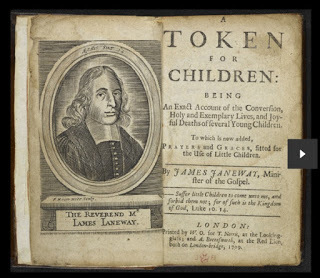 (A Token for Children, 1709 edition; first published around 1672 – British Library)
(A Token for Children, 1709 edition; first published around 1672 – British Library)
Beautifully illustrated spelling books have survived from Queen Anne’s time, and if the modern eye is rather surprised to find that ‘Cherries are pleasant Fruit for Youth to eat’ in roughly the same place in the book as directions for spelling a-po-cry-pha, well, at least those youngsters must have had a rich vocabulary.
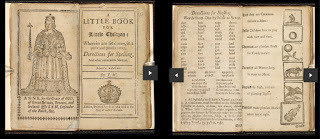 (A Little Book for Little Children, 1702 – British Library)
(A Little Book for Little Children, 1702 – British Library)
Rather than focusing on moral instruction, from the earliest years of the 18th century children’s books had begun to be attractive, colourful and fun .
What better fodder for a young Fitzwilliam Darcy’s imagination than a book he might have found in his father’s library, depicting hundreds of beasts, serpents and insects? He could have spent hours reading about panthers, tigers and scorpions, as well as mythical creatures such as the unicorn and the manticora.
 (Description of Three Hundred Animals, 1730 – British Library)
(Description of Three Hundred Animals, 1730 – British Library)
How about Elizabeth? She might easily have read the tale of Miss Goody Two-Shoes (1765), where the orphaned heroine grows from rags to riches, becomes a schoolmistress and marries the local landowner – so far, so good. But the tale is not aiming for the happily ever after. Instead, Miss Margery inherits her husband’s wealth when he passes away and uses it to help the poor, as she herself was helped as a child.
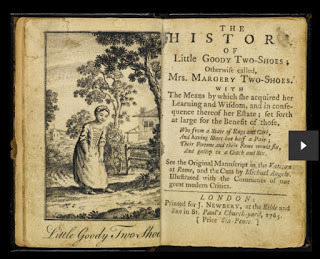 (The History of Little Goody Two-Shoes, 1765 – British Library)
(The History of Little Goody Two-Shoes, 1765 – British Library)
Miss Goody’s tale might be a far cry from the fairytale message we are familiar with, but would you have guessed that, just like little girls nowadays, an eight- or nine-year-old Elizabeth Bennet could have easily read the story of ‘Cinderilla’ and Little Red Riding Hood – if she was not a fictional character herself, that is?
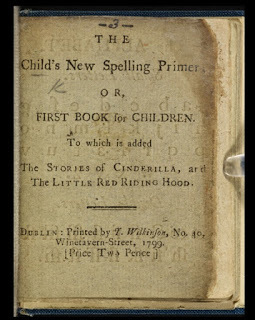 (Spelling Primer, 1799 – British Library)
(Spelling Primer, 1799 – British Library)
There are other gems to be found:
Tommy Thumb's Pretty Song Book (1744) is the first known nursery rhyme collection, featuring early versions of ‘Bah, bah, a black sheep’, ‘Hickory dickory dock’, ‘London Bridge is falling down’ and ‘Sing a song of sixpence’. (It also includes a rhyme about bedwetting that somehow has not made it into the rich heritage passed down to modern children, and who can say if the said heritage is richer or poorer for that? For the inquisitive, you can find out more here.)
 (Tommy Thumb's Pretty Song Book, 1744 – British Library)
(Tommy Thumb's Pretty Song Book, 1744 – British Library)
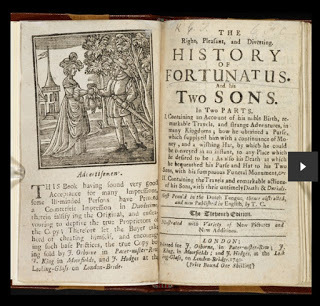 (The Right Pleasant and Diverting History of Fortunatus and His Two Sons, estimated 1740 – British Library)
(The Right Pleasant and Diverting History of Fortunatus and His Two Sons, estimated 1740 – British Library)
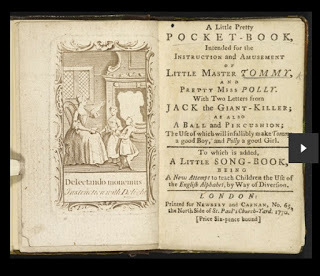 (A Pretty Little Pocket Book, 1770 – British Library)
(A Pretty Little Pocket Book, 1770 – British Library)
The Pretty Little Pocket Book was most innovatively sold with a ball for boys and a pincushion for girls, so that good and bad deeds could be recorded by sticking a pin on the red or the black side of the ball/pincushion. This was the first book published by John Newbery for the entertainment of children. He became known as the father of children’s literature because he was able to turn it into a commercial success. Miss Goody’s tale was his most famous work, and might be regarded as the first children’s novel. An astute businessman, he even started publishing a periodical for children, The Liliputian Magazine, that included stories, riddles and rhymes. His business flourished, was passed to his descendants and survived into the 19th century.
Unlike Mr Newbery’s, in Mr Bennet’s Dutiful Daughter Mr Howe’s bookselling business is fictional, as is his shop and its Darcy patrons – more the pity! But if you would like to read more about Mr Darcy, his family’s purchases at Howe’s and his resulting penchant for currant oatcakes, please leave a comment to enter the international giveaway of a Kindle copy. Also, if you follow the blog tour you might learn more about the oatcakes in a few days’ time. Thank you for stopping by to read this post and many thanks again, Catherine, for the wonderful welcome!
Book Description:
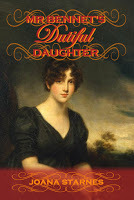 When Colonel Fitzwilliam’s disclosures are interrupted by the bearer of distressing news from Longbourn, Miss Elizabeth Bennet is compelled to consider an offer she would have otherwise dismissed out of hand. An offer of marriage from the all-too-proud Mr Darcy.
When Colonel Fitzwilliam’s disclosures are interrupted by the bearer of distressing news from Longbourn, Miss Elizabeth Bennet is compelled to consider an offer she would have otherwise dismissed out of hand. An offer of marriage from the all-too-proud Mr Darcy.
Yet how is she to live with a husband she hardly knows and does not love? Would she be trapped in a marriage of convenience while events conspire to divide them? Or would love grow as, day by day and hour after hour, she learns to understand the man she married, before she loses his trust and his heart?
Author Links:Facebook: All Roads Lead to Pemberley/ Joana Starnes Facebook PageTwitter: Joana Starnes/ TwitterGoodreads: Joana Starnes Goodreads Author PageAmazon: Joana Starnes Amazon Author Page
Author Biography
 Joana Starnes lives in the south of England with her family. A medical graduate, in more recent years she has developed an unrelated but enduring fascination with Georgian Britain in general and the works of Jane Austen in particular, as well as with the remarkable and flamboyant set of people who have given the Regency Period its charm and sparkle.
Joana Starnes lives in the south of England with her family. A medical graduate, in more recent years she has developed an unrelated but enduring fascination with Georgian Britain in general and the works of Jane Austen in particular, as well as with the remarkable and flamboyant set of people who have given the Regency Period its charm and sparkle.
Joana Starnes is the author of:
* 'From This Day Forward ~ The Darcys of Pemberley', a 'Pride & Prejudice' sequel
* 'The Subsequent Proposal ~ A Tale of Pride, Prejudice & Persuasion'
* 'The Second Chance', a 'Pride & Prejudice' ~ 'Sense & Sensibility' variation
* 'The Falmouth Connection', a 'Pride & Prejudice' variation where Jane Austen's beloved characters are compelled to leave their tame and reasonably peaceful lives in the south of England and travel to the far reaches of Cornwall, into a world of deceit and peril, where few - if any! - are what they seem to be...
* 'The Unthinkable Triangle', a 'Pride & Prejudice' variation that dwells on the most uncomfortable love-triangle of them all. What if Mr. Darcy's rival for Miss Bennet's hand and heart is none other than his dearest, closest friend? And how can they all find their 'happily-ever-after'?
*'Miss Darcy's Companion' - a variation that explores what might have happened if the warm-hearted Miss Elizabeth Bennet were employed instead of the scheming Mrs Younge.
Written content of this post copyright © Joana Starnes, 2016.
---oOo---
“Getting to know you is getting to love you – What would Elizabeth and Mr Darcy have read as children?”
Thank you, Catherine, for welcoming me here today on the blog tour for my latest Pride and Prejudice variation.
Mr Bennet’s Dutiful Daughter is an early-marriage scenario where adverse circumstances compel Elizabeth to accept Mr Darcy’s hand long before she fell in love with him. A reckless choice to the modern woman – yet an eminently prudent one for a Georgian young lady with neither fortune nor connection. But I will not expand on Georgian mores, not here – you do it so much better than I ever will!
Instead, please let me share what I discovered while I was looking into the number of things those timeless characters might have discovered they had in common. It might well be a cliché that Elizabeth and Mr Darcy would talk of books. Setting aside the fact that she refused to discuss reading matter with him at the Netherfield ball, two people with such fondness for the printed word would eventually come to share the pleasure found in old favourites. To me, it was one of the steps towards learning more about each other, while a marriage of convenience and unequal affections grew into a union of all-abiding love.
 (Photo BBC)
(Photo BBC)What is more touching than childhood memories, and what greater proof of trust than the willingness to share them? In Mr Bennet’s Dutiful Daughter Elizabeth and Mr Darcy share recollections of pilfering treats from the pantry and picnicking on the carpet – he with his closest cousin, she with her dearest sister – of romps and mischief, and also of quiet times with books. For Mr Bennet’s favourite daughter and a young boy brought up within reach of the extensive library at Pemberley, books would have doubtlessly held a significant place in their childhood. But what children’s books were available at the time?
Surprisingly many, I discovered as I delved – just online, sadly – into that treasure trove that is the British Library. A wealth of information is available in this article, where Professor M O Grenby “charts the rise of children’s literature throughout the 18th century, explaining how books for children increasingly blended entertainment with instruction.”
I must admit that the attention given to the entertainment element was a great surprise to me. In many early 18th century sources I have found how children were expected to behave like mini-adults (indeed, boys were dressed as mini-adults from the day they were breeched), and while Rousseau and Locke inspired a more liberal attitude to child education for a while, the Victorians came to slow down the process, enforce ‘seen but not heard’ edicts and enshrine the moralising rhyme, the learning by rote and the ubiquitous cane as primary educational tools.
Of course, the cane was an inescapable part of a child’s education until astoundingly recent times, and the Georgians would not have had many scruples about wielding it either. Yet, to my surprise, I discovered that their children were not expected to amuse themselves with some condensed version of Gibbon’s History of the Roman Empire, nor solely with James Janeway’s ‘Exact Account of the Conversion, Holy and Exemplary Lives and Joyful Deaths of Several Young Children’ .
 (A Token for Children, 1709 edition; first published around 1672 – British Library)
(A Token for Children, 1709 edition; first published around 1672 – British Library)Beautifully illustrated spelling books have survived from Queen Anne’s time, and if the modern eye is rather surprised to find that ‘Cherries are pleasant Fruit for Youth to eat’ in roughly the same place in the book as directions for spelling a-po-cry-pha, well, at least those youngsters must have had a rich vocabulary.
 (A Little Book for Little Children, 1702 – British Library)
(A Little Book for Little Children, 1702 – British Library)Rather than focusing on moral instruction, from the earliest years of the 18th century children’s books had begun to be attractive, colourful and fun .
What better fodder for a young Fitzwilliam Darcy’s imagination than a book he might have found in his father’s library, depicting hundreds of beasts, serpents and insects? He could have spent hours reading about panthers, tigers and scorpions, as well as mythical creatures such as the unicorn and the manticora.
 (Description of Three Hundred Animals, 1730 – British Library)
(Description of Three Hundred Animals, 1730 – British Library)How about Elizabeth? She might easily have read the tale of Miss Goody Two-Shoes (1765), where the orphaned heroine grows from rags to riches, becomes a schoolmistress and marries the local landowner – so far, so good. But the tale is not aiming for the happily ever after. Instead, Miss Margery inherits her husband’s wealth when he passes away and uses it to help the poor, as she herself was helped as a child.
 (The History of Little Goody Two-Shoes, 1765 – British Library)
(The History of Little Goody Two-Shoes, 1765 – British Library)Miss Goody’s tale might be a far cry from the fairytale message we are familiar with, but would you have guessed that, just like little girls nowadays, an eight- or nine-year-old Elizabeth Bennet could have easily read the story of ‘Cinderilla’ and Little Red Riding Hood – if she was not a fictional character herself, that is?
 (Spelling Primer, 1799 – British Library)
(Spelling Primer, 1799 – British Library)There are other gems to be found:
Tommy Thumb's Pretty Song Book (1744) is the first known nursery rhyme collection, featuring early versions of ‘Bah, bah, a black sheep’, ‘Hickory dickory dock’, ‘London Bridge is falling down’ and ‘Sing a song of sixpence’. (It also includes a rhyme about bedwetting that somehow has not made it into the rich heritage passed down to modern children, and who can say if the said heritage is richer or poorer for that? For the inquisitive, you can find out more here.)
 (Tommy Thumb's Pretty Song Book, 1744 – British Library)
(Tommy Thumb's Pretty Song Book, 1744 – British Library) (The Right Pleasant and Diverting History of Fortunatus and His Two Sons, estimated 1740 – British Library)
(The Right Pleasant and Diverting History of Fortunatus and His Two Sons, estimated 1740 – British Library) (A Pretty Little Pocket Book, 1770 – British Library)
(A Pretty Little Pocket Book, 1770 – British Library)The Pretty Little Pocket Book was most innovatively sold with a ball for boys and a pincushion for girls, so that good and bad deeds could be recorded by sticking a pin on the red or the black side of the ball/pincushion. This was the first book published by John Newbery for the entertainment of children. He became known as the father of children’s literature because he was able to turn it into a commercial success. Miss Goody’s tale was his most famous work, and might be regarded as the first children’s novel. An astute businessman, he even started publishing a periodical for children, The Liliputian Magazine, that included stories, riddles and rhymes. His business flourished, was passed to his descendants and survived into the 19th century.
Unlike Mr Newbery’s, in Mr Bennet’s Dutiful Daughter Mr Howe’s bookselling business is fictional, as is his shop and its Darcy patrons – more the pity! But if you would like to read more about Mr Darcy, his family’s purchases at Howe’s and his resulting penchant for currant oatcakes, please leave a comment to enter the international giveaway of a Kindle copy. Also, if you follow the blog tour you might learn more about the oatcakes in a few days’ time. Thank you for stopping by to read this post and many thanks again, Catherine, for the wonderful welcome!
Book Description:
 When Colonel Fitzwilliam’s disclosures are interrupted by the bearer of distressing news from Longbourn, Miss Elizabeth Bennet is compelled to consider an offer she would have otherwise dismissed out of hand. An offer of marriage from the all-too-proud Mr Darcy.
When Colonel Fitzwilliam’s disclosures are interrupted by the bearer of distressing news from Longbourn, Miss Elizabeth Bennet is compelled to consider an offer she would have otherwise dismissed out of hand. An offer of marriage from the all-too-proud Mr Darcy.Yet how is she to live with a husband she hardly knows and does not love? Would she be trapped in a marriage of convenience while events conspire to divide them? Or would love grow as, day by day and hour after hour, she learns to understand the man she married, before she loses his trust and his heart?
Author Links:Facebook: All Roads Lead to Pemberley/ Joana Starnes Facebook PageTwitter: Joana Starnes/ TwitterGoodreads: Joana Starnes Goodreads Author PageAmazon: Joana Starnes Amazon Author Page
Author Biography
 Joana Starnes lives in the south of England with her family. A medical graduate, in more recent years she has developed an unrelated but enduring fascination with Georgian Britain in general and the works of Jane Austen in particular, as well as with the remarkable and flamboyant set of people who have given the Regency Period its charm and sparkle.
Joana Starnes lives in the south of England with her family. A medical graduate, in more recent years she has developed an unrelated but enduring fascination with Georgian Britain in general and the works of Jane Austen in particular, as well as with the remarkable and flamboyant set of people who have given the Regency Period its charm and sparkle.Joana Starnes is the author of:
* 'From This Day Forward ~ The Darcys of Pemberley', a 'Pride & Prejudice' sequel
* 'The Subsequent Proposal ~ A Tale of Pride, Prejudice & Persuasion'
* 'The Second Chance', a 'Pride & Prejudice' ~ 'Sense & Sensibility' variation
* 'The Falmouth Connection', a 'Pride & Prejudice' variation where Jane Austen's beloved characters are compelled to leave their tame and reasonably peaceful lives in the south of England and travel to the far reaches of Cornwall, into a world of deceit and peril, where few - if any! - are what they seem to be...
* 'The Unthinkable Triangle', a 'Pride & Prejudice' variation that dwells on the most uncomfortable love-triangle of them all. What if Mr. Darcy's rival for Miss Bennet's hand and heart is none other than his dearest, closest friend? And how can they all find their 'happily-ever-after'?
*'Miss Darcy's Companion' - a variation that explores what might have happened if the warm-hearted Miss Elizabeth Bennet were employed instead of the scheming Mrs Younge.
Written content of this post copyright © Joana Starnes, 2016.
Published on November 19, 2016 16:00
November 16, 2016
A New Home
It's a pleasure to welcome Nicole Clarkston to the salon today, to hear more of Jane Austen and Nicole's latest novel.
Nicole has offered one copy of The Courtship of Edward Gardiner to a comment chosen at random. The contest is open to all and winners can choose between ebook or paperback, so don't forget to leave your comment below!
---oOo---
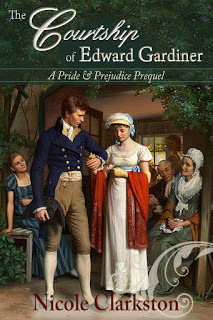 Writing a prequel is an interesting exercise in watching the calendar. Jane Austen published Pride and Prejudice in 1813, and the events in the story span approximately a year of time. Those readers who like to ask such questions might wonder whether the narrative was actually intended to begin in 1812, or whether the final declarations of love should take place in the imaginary “future” of 1814. When I set out to write a prequel, I first had to answer this question. In my mind, the moment a reader first picks up the story is when it truly “begins,” so I chose to think that Fitzwilliam Darcy first insulted Elizabeth Bennet in the fall of 1813. Therefore, the following autumn when he declared himself to be “eight and twenty” would have been the year 1814.
Writing a prequel is an interesting exercise in watching the calendar. Jane Austen published Pride and Prejudice in 1813, and the events in the story span approximately a year of time. Those readers who like to ask such questions might wonder whether the narrative was actually intended to begin in 1812, or whether the final declarations of love should take place in the imaginary “future” of 1814. When I set out to write a prequel, I first had to answer this question. In my mind, the moment a reader first picks up the story is when it truly “begins,” so I chose to think that Fitzwilliam Darcy first insulted Elizabeth Bennet in the fall of 1813. Therefore, the following autumn when he declared himself to be “eight and twenty” would have been the year 1814.
I knew very clearly that I wanted to look at young Darcy at an age when he was still staggering with his new maturity, and reeling from the loss of his mother. I wanted to examine him as he tried to don his famous stiff upper lip, but still lacked the full wisdom and deportment that we see later. I also wanted to introduce Madeline Gardiner to a somewhat rowdy and precocious, yet thoroughly enchanting Elizabeth Bennet. There is some license extended to young children which is not to the elders, and Elizabeth needed to be of an age when she would come to nearly worship her new aunt, thereby looking to her for guidance. To that end, I rolled the clock back an even fourteen years to the year 1800, making Fitzwilliam Darcy aged fourteen, Elizabeth Bennet aged seven, and George III still on his throne.
At this time, the Industrial Revolution had yet to truly flourish, but it was in its infancy. Steam was only beginning to edge out water mills as a source of power. I found it interesting that Austen describes Charles Bingley as one who had come from “the north” and belonged to a family “in trade.” As such, his status would have been very similar to Edward Gardiner’s at this early stage, thus we see both Edward Gardiner and the senior Mr Bingley bumping into each other in the coaching inn. The Bingleys, however, rose in stature rather considerably over the next fourteen years. Since nothing purchases gentility quite so effectively as a large fortune, one must surmise that Mr Bingley Sr did rather well in his trade.
It was quite natural to presume that Mr Bingley might have led the way into the new world of steam powered industry. One of the largest exports from the north of England at the time was wool, which, conveniently, must come from sheep, and this is where Mr Darcy (Sr) of Pemberley steps into the picture. There has and always will be an established way of doing things, and those who find creative alternatives often hold an advantage over their rivals. Mr Bingley proposes to Mr Darcy a mutually advantageous scheme- paying more for his raw material, but at the same time finding himself some loyal suppliers to continue feeding his more efficient mill.
Although this story is primarily intended to be a sweet love story, the realities of life do intrude in a few other areas. One notable place is in Edward Gardiner’s business life. One of his rivals has taken a rather substantial blow when two of his merchant ships encountered a storm. Not all merchants would have owned their own vessels, but the larger ones certainly might have.
For a man in trade, such as Gardiner or his counterparts, owning their own vessel was a massive investment. It was not only the purchase of the ship and the paying of the hands, but also the establishment of a profitable trade route. Sending a ship halfway around the world to bring back a load of goods was a massive undertaking, and could only pay out if there were strategic ports of call and sufficient quantities of merchandise to justify such an effort. For smaller businesses, it often made more sense to partner with others to share the expenses and risks, or simply to contract with a private merchant ship for cargo passage. Edward’s rival had formed a partnership to launch himself into this very position, and taken a crippling loss as a result. Perhaps from this incident, Edward Gardiner always remained careful and well-reasoned in his business ventures.
There are a few other touches from the grit and reality of history, but “The Courtship of Edward Gardiner” was really intended to be a history of individuals. How did Fitzwilliam Darcy and Charles Bingley forge their unlikely friendship? How did Elizabeth and Jane Bennet develop such a close bond with their aunt Gardiner? How did Edward Gardiner rise from his humble position in Meryton to his consequence in London? And, most importantly to any prequel: How did past events set the “future” into motion?
The following vignette takes place just after the events of “The Courtship of Edward Gardiner.” Edward and Madeline have just returned from their wedding trip to a new home, and some very well-meaning souls have undertaken to make them feel welcome. Once more, we see a glimpse of how relationships began, and are able to follow the path to where they led.
A New Home
Madeline Gardiner stood hesitantly before the spacious entry of her new home. For a moment, her eyes swept up the stone columns and traced the high archway curving over her head. Like many of the newer homes in Gracechurch street, the building aspired to modest gentility, tempered only somewhat by economy. Perhaps it would not have impressed those of high standing, nor even one truly accustomed to the lavish architecture of London. Madeline, however, reared in a simple village and a humble home, was absolutely breathless. All this… was to be hers?
She and Edward had toured the home in the first few days after their wedding, during his brief stop in Town to wrap up some business affairs. The house had become available just before their departure, and it had been priced attractively. Edward had quickly set a purchase in motion, and then they had taken the remainder of their wedding tour. Three weeks later now, they had returned, and the house was theirs. Or, rather, the structure was lawfully in their name, and Edward’s manservant had opened the door for them. It did not yet seem like her own. Peering nervously inside, she verified for herself what she already knew to be the truth: though the house did not yet possess the comforts of home, neither was it precisely empty.
“My dearest sister!” Fanny Bennet gushed through the door, her arms held aloft in jubilant welcome. “Was your journey comfortable? We did not look for you until the morrow! Oh, we have so much to show you. Come, come!”
Madeline cast a brave, sidelong glance to Edward. He smiled tightly down at her. He had- with Madeline’s blessing- allowed his sisters to settle some of the initial furnishings for their new home, so that he and his bride might immediately take up residence upon their return. It had not been without some trepidation that he had done so, but he had judged it preferable to tolerate a small degree of his sister’s taste, rather than to take Madeline back to his old bachelor flat. After all, he had asked only for the necessities to be sorted, and there had been very little time for Fanny and Dina to become too carried away. Besides, their husbands would have exercised some measure of restraining influence over them… surely.
“Now, you must close your eyes,” Mrs Bennet was insisting. “Oh, Edward, do you know nothing? You must carry your bride! Our Mama always did despair of you. No, no, over your right shoulder! Brother, you are quite as impossible as Mr Bennet. There, now, that is quite proper! Are you quite ready?”
Madeline, wrapped securely in Edward’s obliging embrace, squinted her eyes tightly closed. When the pitch of Fanny Bennet’s voice indicated that she had at last turned her attention away, Madeline risked a quick wink and smile. Edward rewarded her daring glance with a low rumble of laughter in his chest. “Welcome home, my dear,” he whispered near her ear, sealing his words with a light kiss to the edge of her bonnet. An observer would scarcely have noticed the small affection, but Madeline knew it for what it was; a promise, a troth, an effusion of genuine adoration- and, not least, a precursor to hours of shared intimacies, the like of which she had never before conceived.
For a moment, Madeline’s being surged in pride and delight. This caring, wonderful, passionate man had made himself her own. Every regard and sentiment dreamt in the most fanciful of girlish hearts was now hers to claim in the being of a respectable, intelligent man- one who also intended to provide for her more lavishly than the most fortunate of her prior acquaintance. She was truly blessed in every particular! The sentimental moment passed quickly, for the next, she was choking back a peal of unseemly laughter at his irreverence. “I pray my sister did not learn of my account at the lace shop!” he murmured between clenched teeth.
Cradled in Edward’s arms, Madeline officially took up the mantle of Mistress of her new home. She started to open her eyes, but a shrieked admonishment from Fanny Bennet caused her to clench them once more. She counted Edward’s steps, felt his body shift as he turned to the left, and bit down eagerly upon her lower lip to contain her impatience. Her resolve crumbled when he gasped and nearly dropped her.
“Wh… wh…. F-fanny?” he was stammering uncertainly. Numbly, he set Madeline’s feet upon the floor and braced an arm about her as she found her balance, but his eyes were roving the room in mute astonishment.
Madeline was no less in awe. The drawing room she had first seen as a vacant cavern, and for which she had fancied a few simple, tasteful furnishings to start, had been utterly transformed. A veritable bower of cushions, doilies, paintings, and floral arrangements assaulted her senses, and the narrow pathway through the room wove about the furnishings in an intricate trail fit only for a ballerina. “Fanny!” she breathed. “I… I am all amazement!”
“Oh!” the woman waved a modest handkerchief. “I only arranged the little extras. Our brother and sister Phillips chose the larger furnishings. Is not this a simply exquisite tapestry? And the cloth on this little settee, only wait until you see how many roses!”
Madeline’s shocked gaze found Geraldine Philips, who stood beside her husband in serene approval. “Your account for the furnishings will need to be settled this week, Brother, for the purveyor was hesitant to extend so much at once. He did not wish to do so at all, but Mr Philips persuaded him, did you not, my dear? It was simply unthinkable to leave the job half done!”
“Th-thank you, Dina,” she gasped. “It is… why, it is….”
“Expensive,” a voice finished drily.
As one, Madeline and Edward turned toward the mantel. Thomas Bennet leant against it with his elbow, cradling a cup of tea in his near hand. Edward swallowed visibly and nodded in greeting. “Thomas,” he coughed, “I, er, hope you have not permitted my sister to exhaust herself on our account!”
“Oh, you must not give it a second thought!” insisted that good lady. “Is that not right, Dina? Why, I declare, we never had such a time in our lives as the day we found these little cushions. And the lace! Why, I had no notion that your shop in Town was so fine! I cannot fathom that Mr Bennet has never thought before that I should like to see it!”
“There, you see?” Bennet offered a sly little smile. “You have not inconvenienced my wife in the least.”
Edward narrowed his eyes very slightly. “I am glad to hear it, Thomas.”
“Well, well, my dear, are you not planning to show them about the rest of the house?” Bennet goaded. Madeline was certain that she caught a gleam of mischief in the man’s eye. There could be no doubt of Lizzy’s parentage! she thought. Somehow the witty father and the high-spirited mother both lived on in their daughter, and she found that they resembled her rather more than the reverse.
“You simply must examine the dining chairs,” concurred Geraldine. “Mr Philips at first fancied a more elegant set, but you do know how a man will put on weight once he has married! I thought the sturdier set would be the wiser choice. Just see if you do not agree!”
Madeline gulped as Edward slid a hand to the small of her back, guiding her toward that part of the house. Every surface, every wall, every little cranny was stuffed and plumped and bedecked with all imaginable sort of feminine comfort. To be truthful, there was not a single piece which was not lovely and welcoming, but taken as a whole, it was as though a carriage of shoe roses and poseys had exploded inside the building. No longer could the house seem too large and too imposing- no, not even the massive homes of Grosvenor Square could withstand so many little baubles and trinkets, and still maintain their stately grandeur.
Madeline paused within the dining room, chuckling as Geraldine Philips fairly thrust her brother into a dining chair to test its strength. Edward accepted the rough handling with grace and not a little bemusement, as his eyes, too, struggled to take in the overpowering luxury. This room also groaned under the evidence of Fanny’s heavy-handed decorating philosophy. The table might have been a fine specimen, had any bits of it been visible beneath the bona fide flower garden springing from its centerpiece. The rug was so thick that Madeline, in her narrow walking shoes, nearly lost her balance when her foot sank. One wall was laden with no less than four paintings, and the other boasted a buffet which stretched from one end to the other- for, apparently, Edward’s old one had been deemed inadequate to the task of serving their future family.
“Dina, Fanny,” Edward was shaking his head still, his gaze faintly glassy, “I had not expected you to trouble yourselves….”
“Oh! It was no trouble at all!” his middle sister assured him. “Mr Bennet said how he was quite confident that you and your bride would wish to come to a ready-appointed home, and so we thought to do all that was necessary. Look here, Madeline!” Fanny actually grasped Madeline’s hand and led her bewildered sister through another sumptuously adorned corridor, through to somewhat smaller room. “Fancy this, you have your own private sitting room!”
Madeline’s eyes rounded still more. If the main drawing room could be called “comfortable,” this bastion of femininity could only be described as “adhesive.” Why, if she fell into that sofa, it might take three people to rescue her! “Fanny,” she whispered in awe, “you have truly out-done yourself!”
“I am so glad to hear that you love it!” Fanny Bennet, one of the silliest women Madeline could count among her acquaintance, took her hand once more. Her face shone with sincere feeling, even as every feature trembled in girlish delight. “Do you know, I was so hoping that Edward would find a nice wife, and I think you have made him very happy. Oh, yes, I know what a change it must have been from your old home, but Dina and I wished for you to be quite comfortable here. Do you truly love it?”
Madeline felt her own eyes pricking with tears. Giddy, and at times ridiculous though Mrs Bennet might be, a heart of gold beat within that good woman. “Yes, Fanny, I do. It is clear that you know how to make one feel at home!” Her compliment was well-received, for the older woman nearly squealed in delight. Madeline repressed an amused sigh. She fully expected to encounter many occasions to roll her eyes at her new sister’s frivolities, but her affection and genuine good-will could never be doubted.
Edward had at last completed his task of “testing” each dining chair at Geraldine’s pleasure, and drew near. “I do hope, sisters, that you have not worked your arts on every room in the house! I… do not know how guilty I shall feel that you have gone to such trouble.” “Nor,” he whispered to Madeline as his sister turned away, “how my pocketbook shall sustain such a violation.”
Madeline snickered silently as Fanny answered. “Oh! Mr Bennet would not allow us to touch the library, nor even your quarters, Edward. Oh, but Sister, your own chambers! Oh, you will simply swoon!”
Edward cleared his throat with a grateful nod toward Thomas Bennet, who still stood by with a mild smirk. “I believe,” he commented, “that it will take three maids each morning for your chambers alone, Mrs Gardiner.”
Brimming with trepidation, the new couple mounted the stairs behind Edward’s bubbling elder sisters. Edward’s face was still drained of all colour.
“My dear,” Madeline murmured wickedly under her breath, “I think it may be safer that I should instead share your quarters, instead of becoming forever lost in my own!”
A sudden beam of mischief lit upon his face. “A capital idea! I shall be certain to tell my sister how… useful I have found her kindness.”
About the Book
Every great love has a beginning. In Austen's Pride and Prejudice, we meet with perhaps the most sensible, caring relatives a lovelorn young woman could hope for: Mr and Mrs Gardiner. What is their story?Edward Gardiner has just been refused by the lovely young woman he had intended to make his wife. Heartbroken and eager for a diversion, he accepts an invitation from his brother-in-law, Thomas Bennet, to accompany him along with his two eldest daughters to the north on family business. Gardiner's pleasure tour is interrupted, however, when his eldest niece falls ill and is unable to travel farther. Stopping over in the scarcely remarkable village of Lambton, the men decide that Bennet must continue on, while Gardiner and the children remain. The only trouble is that Gardiner has not the least idea how he should care for one ailing niece and another who is ready to drive him to distraction... until he meets with Madeline Fairbanks.
About the Author Nicole Clarkston is the pen name of a very bashful writer who will not allow any of her family or friends to read what she writes. She grew up in Idaho on horseback, and if she could have figured out how to read a book at the same time, she would have. She initially pursued a degree in foreign languages and education, and then lost patience with it, switched her major, and changed schools. She now resides in Oregon with her husband of 15 years, 3 homeschooled kids, and a very worthless degree in Poultry Science (don't ask).
Nicole Clarkston is the pen name of a very bashful writer who will not allow any of her family or friends to read what she writes. She grew up in Idaho on horseback, and if she could have figured out how to read a book at the same time, she would have. She initially pursued a degree in foreign languages and education, and then lost patience with it, switched her major, and changed schools. She now resides in Oregon with her husband of 15 years, 3 homeschooled kids, and a very worthless degree in Poultry Science (don't ask).
Nicole discovered Jane Austen rather by guilt in her early thirties- how does any book worm really live that long without a little P&P? She has never looked back. A year or so later, during a major house renovation project (undertaken when her husband unsuspectingly left town for a few days) she discovered Elizabeth Gaskell and fell completely in love. Nicole's books are her pitiful homage to two authors who have so deeply inspired her.
WebsiteGoodreads Author PageGoodreads BlogFacebookAmazon Author Page
Buy Link:
The Courtship of Edward Gardiner
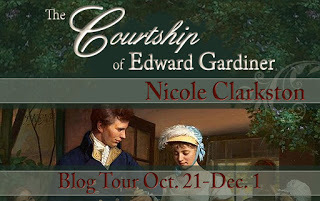
10/21: Guest Post, Excerpt & Giveaway at More Agreeably Engaged10/22: Review & Giveaway at Just Jane 181310/27: Review & Giveaway Savvy Verse & Wit11/01: Excerpt & Giveaway at Half Agony, Half Hope11/08: Guest Post & Giveaway So little time…11/11: Guest Post & Giveaway at Babblings of a Bookworm11/15: Review & Giveaway at My Vices and Weaknesses11/17: Guest Post & Giveaway at A Covent Garden Gilflurt’s Guide to Life11/26: Excerpt & Giveaway at Margie’s Must Reads11/30: Review & Giveaway at Diary of an Eccentric12/01: Guest Post & Giveaway at From Pemberley to Milton
Written content of this post copyright © Nicole Clarkston, 2016.
Nicole has offered one copy of The Courtship of Edward Gardiner to a comment chosen at random. The contest is open to all and winners can choose between ebook or paperback, so don't forget to leave your comment below!
---oOo---
 Writing a prequel is an interesting exercise in watching the calendar. Jane Austen published Pride and Prejudice in 1813, and the events in the story span approximately a year of time. Those readers who like to ask such questions might wonder whether the narrative was actually intended to begin in 1812, or whether the final declarations of love should take place in the imaginary “future” of 1814. When I set out to write a prequel, I first had to answer this question. In my mind, the moment a reader first picks up the story is when it truly “begins,” so I chose to think that Fitzwilliam Darcy first insulted Elizabeth Bennet in the fall of 1813. Therefore, the following autumn when he declared himself to be “eight and twenty” would have been the year 1814.
Writing a prequel is an interesting exercise in watching the calendar. Jane Austen published Pride and Prejudice in 1813, and the events in the story span approximately a year of time. Those readers who like to ask such questions might wonder whether the narrative was actually intended to begin in 1812, or whether the final declarations of love should take place in the imaginary “future” of 1814. When I set out to write a prequel, I first had to answer this question. In my mind, the moment a reader first picks up the story is when it truly “begins,” so I chose to think that Fitzwilliam Darcy first insulted Elizabeth Bennet in the fall of 1813. Therefore, the following autumn when he declared himself to be “eight and twenty” would have been the year 1814.I knew very clearly that I wanted to look at young Darcy at an age when he was still staggering with his new maturity, and reeling from the loss of his mother. I wanted to examine him as he tried to don his famous stiff upper lip, but still lacked the full wisdom and deportment that we see later. I also wanted to introduce Madeline Gardiner to a somewhat rowdy and precocious, yet thoroughly enchanting Elizabeth Bennet. There is some license extended to young children which is not to the elders, and Elizabeth needed to be of an age when she would come to nearly worship her new aunt, thereby looking to her for guidance. To that end, I rolled the clock back an even fourteen years to the year 1800, making Fitzwilliam Darcy aged fourteen, Elizabeth Bennet aged seven, and George III still on his throne.
At this time, the Industrial Revolution had yet to truly flourish, but it was in its infancy. Steam was only beginning to edge out water mills as a source of power. I found it interesting that Austen describes Charles Bingley as one who had come from “the north” and belonged to a family “in trade.” As such, his status would have been very similar to Edward Gardiner’s at this early stage, thus we see both Edward Gardiner and the senior Mr Bingley bumping into each other in the coaching inn. The Bingleys, however, rose in stature rather considerably over the next fourteen years. Since nothing purchases gentility quite so effectively as a large fortune, one must surmise that Mr Bingley Sr did rather well in his trade.
It was quite natural to presume that Mr Bingley might have led the way into the new world of steam powered industry. One of the largest exports from the north of England at the time was wool, which, conveniently, must come from sheep, and this is where Mr Darcy (Sr) of Pemberley steps into the picture. There has and always will be an established way of doing things, and those who find creative alternatives often hold an advantage over their rivals. Mr Bingley proposes to Mr Darcy a mutually advantageous scheme- paying more for his raw material, but at the same time finding himself some loyal suppliers to continue feeding his more efficient mill.
Although this story is primarily intended to be a sweet love story, the realities of life do intrude in a few other areas. One notable place is in Edward Gardiner’s business life. One of his rivals has taken a rather substantial blow when two of his merchant ships encountered a storm. Not all merchants would have owned their own vessels, but the larger ones certainly might have.
For a man in trade, such as Gardiner or his counterparts, owning their own vessel was a massive investment. It was not only the purchase of the ship and the paying of the hands, but also the establishment of a profitable trade route. Sending a ship halfway around the world to bring back a load of goods was a massive undertaking, and could only pay out if there were strategic ports of call and sufficient quantities of merchandise to justify such an effort. For smaller businesses, it often made more sense to partner with others to share the expenses and risks, or simply to contract with a private merchant ship for cargo passage. Edward’s rival had formed a partnership to launch himself into this very position, and taken a crippling loss as a result. Perhaps from this incident, Edward Gardiner always remained careful and well-reasoned in his business ventures.
There are a few other touches from the grit and reality of history, but “The Courtship of Edward Gardiner” was really intended to be a history of individuals. How did Fitzwilliam Darcy and Charles Bingley forge their unlikely friendship? How did Elizabeth and Jane Bennet develop such a close bond with their aunt Gardiner? How did Edward Gardiner rise from his humble position in Meryton to his consequence in London? And, most importantly to any prequel: How did past events set the “future” into motion?
The following vignette takes place just after the events of “The Courtship of Edward Gardiner.” Edward and Madeline have just returned from their wedding trip to a new home, and some very well-meaning souls have undertaken to make them feel welcome. Once more, we see a glimpse of how relationships began, and are able to follow the path to where they led.
A New Home
Madeline Gardiner stood hesitantly before the spacious entry of her new home. For a moment, her eyes swept up the stone columns and traced the high archway curving over her head. Like many of the newer homes in Gracechurch street, the building aspired to modest gentility, tempered only somewhat by economy. Perhaps it would not have impressed those of high standing, nor even one truly accustomed to the lavish architecture of London. Madeline, however, reared in a simple village and a humble home, was absolutely breathless. All this… was to be hers?
She and Edward had toured the home in the first few days after their wedding, during his brief stop in Town to wrap up some business affairs. The house had become available just before their departure, and it had been priced attractively. Edward had quickly set a purchase in motion, and then they had taken the remainder of their wedding tour. Three weeks later now, they had returned, and the house was theirs. Or, rather, the structure was lawfully in their name, and Edward’s manservant had opened the door for them. It did not yet seem like her own. Peering nervously inside, she verified for herself what she already knew to be the truth: though the house did not yet possess the comforts of home, neither was it precisely empty.
“My dearest sister!” Fanny Bennet gushed through the door, her arms held aloft in jubilant welcome. “Was your journey comfortable? We did not look for you until the morrow! Oh, we have so much to show you. Come, come!”
Madeline cast a brave, sidelong glance to Edward. He smiled tightly down at her. He had- with Madeline’s blessing- allowed his sisters to settle some of the initial furnishings for their new home, so that he and his bride might immediately take up residence upon their return. It had not been without some trepidation that he had done so, but he had judged it preferable to tolerate a small degree of his sister’s taste, rather than to take Madeline back to his old bachelor flat. After all, he had asked only for the necessities to be sorted, and there had been very little time for Fanny and Dina to become too carried away. Besides, their husbands would have exercised some measure of restraining influence over them… surely.
“Now, you must close your eyes,” Mrs Bennet was insisting. “Oh, Edward, do you know nothing? You must carry your bride! Our Mama always did despair of you. No, no, over your right shoulder! Brother, you are quite as impossible as Mr Bennet. There, now, that is quite proper! Are you quite ready?”
Madeline, wrapped securely in Edward’s obliging embrace, squinted her eyes tightly closed. When the pitch of Fanny Bennet’s voice indicated that she had at last turned her attention away, Madeline risked a quick wink and smile. Edward rewarded her daring glance with a low rumble of laughter in his chest. “Welcome home, my dear,” he whispered near her ear, sealing his words with a light kiss to the edge of her bonnet. An observer would scarcely have noticed the small affection, but Madeline knew it for what it was; a promise, a troth, an effusion of genuine adoration- and, not least, a precursor to hours of shared intimacies, the like of which she had never before conceived.
For a moment, Madeline’s being surged in pride and delight. This caring, wonderful, passionate man had made himself her own. Every regard and sentiment dreamt in the most fanciful of girlish hearts was now hers to claim in the being of a respectable, intelligent man- one who also intended to provide for her more lavishly than the most fortunate of her prior acquaintance. She was truly blessed in every particular! The sentimental moment passed quickly, for the next, she was choking back a peal of unseemly laughter at his irreverence. “I pray my sister did not learn of my account at the lace shop!” he murmured between clenched teeth.
Cradled in Edward’s arms, Madeline officially took up the mantle of Mistress of her new home. She started to open her eyes, but a shrieked admonishment from Fanny Bennet caused her to clench them once more. She counted Edward’s steps, felt his body shift as he turned to the left, and bit down eagerly upon her lower lip to contain her impatience. Her resolve crumbled when he gasped and nearly dropped her.
“Wh… wh…. F-fanny?” he was stammering uncertainly. Numbly, he set Madeline’s feet upon the floor and braced an arm about her as she found her balance, but his eyes were roving the room in mute astonishment.
Madeline was no less in awe. The drawing room she had first seen as a vacant cavern, and for which she had fancied a few simple, tasteful furnishings to start, had been utterly transformed. A veritable bower of cushions, doilies, paintings, and floral arrangements assaulted her senses, and the narrow pathway through the room wove about the furnishings in an intricate trail fit only for a ballerina. “Fanny!” she breathed. “I… I am all amazement!”
“Oh!” the woman waved a modest handkerchief. “I only arranged the little extras. Our brother and sister Phillips chose the larger furnishings. Is not this a simply exquisite tapestry? And the cloth on this little settee, only wait until you see how many roses!”
Madeline’s shocked gaze found Geraldine Philips, who stood beside her husband in serene approval. “Your account for the furnishings will need to be settled this week, Brother, for the purveyor was hesitant to extend so much at once. He did not wish to do so at all, but Mr Philips persuaded him, did you not, my dear? It was simply unthinkable to leave the job half done!”
“Th-thank you, Dina,” she gasped. “It is… why, it is….”
“Expensive,” a voice finished drily.
As one, Madeline and Edward turned toward the mantel. Thomas Bennet leant against it with his elbow, cradling a cup of tea in his near hand. Edward swallowed visibly and nodded in greeting. “Thomas,” he coughed, “I, er, hope you have not permitted my sister to exhaust herself on our account!”
“Oh, you must not give it a second thought!” insisted that good lady. “Is that not right, Dina? Why, I declare, we never had such a time in our lives as the day we found these little cushions. And the lace! Why, I had no notion that your shop in Town was so fine! I cannot fathom that Mr Bennet has never thought before that I should like to see it!”
“There, you see?” Bennet offered a sly little smile. “You have not inconvenienced my wife in the least.”
Edward narrowed his eyes very slightly. “I am glad to hear it, Thomas.”
“Well, well, my dear, are you not planning to show them about the rest of the house?” Bennet goaded. Madeline was certain that she caught a gleam of mischief in the man’s eye. There could be no doubt of Lizzy’s parentage! she thought. Somehow the witty father and the high-spirited mother both lived on in their daughter, and she found that they resembled her rather more than the reverse.
“You simply must examine the dining chairs,” concurred Geraldine. “Mr Philips at first fancied a more elegant set, but you do know how a man will put on weight once he has married! I thought the sturdier set would be the wiser choice. Just see if you do not agree!”
Madeline gulped as Edward slid a hand to the small of her back, guiding her toward that part of the house. Every surface, every wall, every little cranny was stuffed and plumped and bedecked with all imaginable sort of feminine comfort. To be truthful, there was not a single piece which was not lovely and welcoming, but taken as a whole, it was as though a carriage of shoe roses and poseys had exploded inside the building. No longer could the house seem too large and too imposing- no, not even the massive homes of Grosvenor Square could withstand so many little baubles and trinkets, and still maintain their stately grandeur.
Madeline paused within the dining room, chuckling as Geraldine Philips fairly thrust her brother into a dining chair to test its strength. Edward accepted the rough handling with grace and not a little bemusement, as his eyes, too, struggled to take in the overpowering luxury. This room also groaned under the evidence of Fanny’s heavy-handed decorating philosophy. The table might have been a fine specimen, had any bits of it been visible beneath the bona fide flower garden springing from its centerpiece. The rug was so thick that Madeline, in her narrow walking shoes, nearly lost her balance when her foot sank. One wall was laden with no less than four paintings, and the other boasted a buffet which stretched from one end to the other- for, apparently, Edward’s old one had been deemed inadequate to the task of serving their future family.
“Dina, Fanny,” Edward was shaking his head still, his gaze faintly glassy, “I had not expected you to trouble yourselves….”
“Oh! It was no trouble at all!” his middle sister assured him. “Mr Bennet said how he was quite confident that you and your bride would wish to come to a ready-appointed home, and so we thought to do all that was necessary. Look here, Madeline!” Fanny actually grasped Madeline’s hand and led her bewildered sister through another sumptuously adorned corridor, through to somewhat smaller room. “Fancy this, you have your own private sitting room!”
Madeline’s eyes rounded still more. If the main drawing room could be called “comfortable,” this bastion of femininity could only be described as “adhesive.” Why, if she fell into that sofa, it might take three people to rescue her! “Fanny,” she whispered in awe, “you have truly out-done yourself!”
“I am so glad to hear that you love it!” Fanny Bennet, one of the silliest women Madeline could count among her acquaintance, took her hand once more. Her face shone with sincere feeling, even as every feature trembled in girlish delight. “Do you know, I was so hoping that Edward would find a nice wife, and I think you have made him very happy. Oh, yes, I know what a change it must have been from your old home, but Dina and I wished for you to be quite comfortable here. Do you truly love it?”
Madeline felt her own eyes pricking with tears. Giddy, and at times ridiculous though Mrs Bennet might be, a heart of gold beat within that good woman. “Yes, Fanny, I do. It is clear that you know how to make one feel at home!” Her compliment was well-received, for the older woman nearly squealed in delight. Madeline repressed an amused sigh. She fully expected to encounter many occasions to roll her eyes at her new sister’s frivolities, but her affection and genuine good-will could never be doubted.
Edward had at last completed his task of “testing” each dining chair at Geraldine’s pleasure, and drew near. “I do hope, sisters, that you have not worked your arts on every room in the house! I… do not know how guilty I shall feel that you have gone to such trouble.” “Nor,” he whispered to Madeline as his sister turned away, “how my pocketbook shall sustain such a violation.”
Madeline snickered silently as Fanny answered. “Oh! Mr Bennet would not allow us to touch the library, nor even your quarters, Edward. Oh, but Sister, your own chambers! Oh, you will simply swoon!”
Edward cleared his throat with a grateful nod toward Thomas Bennet, who still stood by with a mild smirk. “I believe,” he commented, “that it will take three maids each morning for your chambers alone, Mrs Gardiner.”
Brimming with trepidation, the new couple mounted the stairs behind Edward’s bubbling elder sisters. Edward’s face was still drained of all colour.
“My dear,” Madeline murmured wickedly under her breath, “I think it may be safer that I should instead share your quarters, instead of becoming forever lost in my own!”
A sudden beam of mischief lit upon his face. “A capital idea! I shall be certain to tell my sister how… useful I have found her kindness.”
About the Book
Every great love has a beginning. In Austen's Pride and Prejudice, we meet with perhaps the most sensible, caring relatives a lovelorn young woman could hope for: Mr and Mrs Gardiner. What is their story?Edward Gardiner has just been refused by the lovely young woman he had intended to make his wife. Heartbroken and eager for a diversion, he accepts an invitation from his brother-in-law, Thomas Bennet, to accompany him along with his two eldest daughters to the north on family business. Gardiner's pleasure tour is interrupted, however, when his eldest niece falls ill and is unable to travel farther. Stopping over in the scarcely remarkable village of Lambton, the men decide that Bennet must continue on, while Gardiner and the children remain. The only trouble is that Gardiner has not the least idea how he should care for one ailing niece and another who is ready to drive him to distraction... until he meets with Madeline Fairbanks.
About the Author
 Nicole Clarkston is the pen name of a very bashful writer who will not allow any of her family or friends to read what she writes. She grew up in Idaho on horseback, and if she could have figured out how to read a book at the same time, she would have. She initially pursued a degree in foreign languages and education, and then lost patience with it, switched her major, and changed schools. She now resides in Oregon with her husband of 15 years, 3 homeschooled kids, and a very worthless degree in Poultry Science (don't ask).
Nicole Clarkston is the pen name of a very bashful writer who will not allow any of her family or friends to read what she writes. She grew up in Idaho on horseback, and if she could have figured out how to read a book at the same time, she would have. She initially pursued a degree in foreign languages and education, and then lost patience with it, switched her major, and changed schools. She now resides in Oregon with her husband of 15 years, 3 homeschooled kids, and a very worthless degree in Poultry Science (don't ask). Nicole discovered Jane Austen rather by guilt in her early thirties- how does any book worm really live that long without a little P&P? She has never looked back. A year or so later, during a major house renovation project (undertaken when her husband unsuspectingly left town for a few days) she discovered Elizabeth Gaskell and fell completely in love. Nicole's books are her pitiful homage to two authors who have so deeply inspired her.
WebsiteGoodreads Author PageGoodreads BlogFacebookAmazon Author Page
Buy Link:
The Courtship of Edward Gardiner

10/21: Guest Post, Excerpt & Giveaway at More Agreeably Engaged10/22: Review & Giveaway at Just Jane 181310/27: Review & Giveaway Savvy Verse & Wit11/01: Excerpt & Giveaway at Half Agony, Half Hope11/08: Guest Post & Giveaway So little time…11/11: Guest Post & Giveaway at Babblings of a Bookworm11/15: Review & Giveaway at My Vices and Weaknesses11/17: Guest Post & Giveaway at A Covent Garden Gilflurt’s Guide to Life11/26: Excerpt & Giveaway at Margie’s Must Reads11/30: Review & Giveaway at Diary of an Eccentric12/01: Guest Post & Giveaway at From Pemberley to Milton
Written content of this post copyright © Nicole Clarkston, 2016.
Published on November 16, 2016 16:00
November 15, 2016
Jane Austen’s England Kickstarter
Karin Quint is our salon guest today, to share news of an exciting new jane Austen project!
---oOo---
The lovely port of Charlestown, Cornwall is used in many films en period dramas. Lately for instance in Poldark. If you look closely you can spot white doves flying around. You probably did not know they are there because of Jane Austen’s novel Mansfield Park. Want to know why? The answer is in Jane Austen’s England. This travel guide to everything Austen is now only available for pre-ordering on Kickstarter until December 7th. (link: http://kck.st/2fuhfJJ)
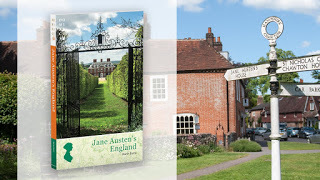
Jane Austen’s England was published in Dutch in 2014 as Het Engeland van Jane Austen. It takes you to more than 200 places in England that have a connection with Jane Austen’s life, her work, or the film adaptations of her novels. If we reach our funding goal, an exclusive English edition will be printed that will not be available in stores or anywhere else.
I am a huge Jane Austen fan. I’ve read the novels multiple times, read many biographies and seen the movies and the series over and over again. Whenever I visit England (which I like to do a lot) I like to go to locations that have a connection with my favourite author. I love visiting the Jane Austen’s House Museum in Chawton, or, when I am further up north, visit one of the Pemberley’s from the films (Chatsworth, Lyme Park) or find the lake Mr Darcy didn’t really jump into.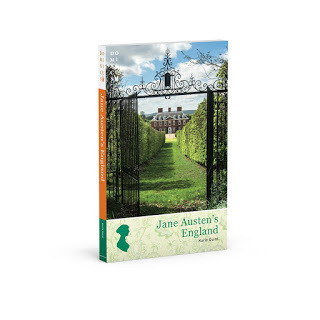 I am not the only one who likes to visit these places. In 2009 I started the Dutch website JaneAusten.nl and found out that there are many like me. At one point, after advising many others about their Austen tours to England, I got the idea of writing a comprehensive travel guide. The second edition was published last summer and it is still selling very well in The Netherlands and Belgium.
I am not the only one who likes to visit these places. In 2009 I started the Dutch website JaneAusten.nl and found out that there are many like me. At one point, after advising many others about their Austen tours to England, I got the idea of writing a comprehensive travel guide. The second edition was published last summer and it is still selling very well in The Netherlands and Belgium.
Because I really think more people will enjoy this book, I started a Kickstarter crowdfunding campaign last week. My goal is to publish the guidebook in English. By letting people order a copy of the book in advance through Kickstarter, we can raise the funds we need to have the book translated, printed and shipped to our Kickstarter backers.
Each location in the book includes its history, an extensive description of the link with Austen, and practical information such as address, phone number and opening hours. And where possible, I added relevant quotes from Jane’s novels or letters and nice-to-know anecdotes, like that one about the white doves of Charlestown.
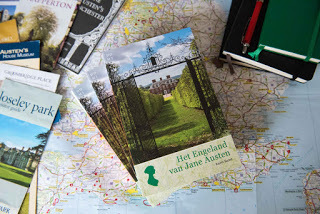
Do you want to travel in Jane Austen’s footsteps? Then order your copy of the book on Kickstarter now! (link: http://kck.st/2fuhfJJ) And tell your Jane Austen loving friends about the book. Because only if enough people back the campaign, Jane Austen’s England will become a reality.
About the author Karin Quint (1976) is a journalist, photographer and founder of the Dutch website and community JaneAusten.nl. She first became acquainted with Jane Austen’s work in the 1990s when she bought a well-thumbed copy of De Gezusters Bennet (The Bennet Sisters) at a flea market for just ten cents. Unknowingly she had just purchased one of the best-loved novels in English literature – Pride and Prejudice. She read the book in one go. From that moment, she was hooked and became a true “Janeite”.
Karin Quint (1976) is a journalist, photographer and founder of the Dutch website and community JaneAusten.nl. She first became acquainted with Jane Austen’s work in the 1990s when she bought a well-thumbed copy of De Gezusters Bennet (The Bennet Sisters) at a flea market for just ten cents. Unknowingly she had just purchased one of the best-loved novels in English literature – Pride and Prejudice. She read the book in one go. From that moment, she was hooked and became a true “Janeite”.
In 2009 she started JaneAusten.nl and through this website got to know many Austen lovers from The Netherlands, Belgium and further abroad. Over the years, she was increasingly asked for advice about making Jane Austen tours. But a guidebook containing all locations related to Austen and her work was nowhere to be found. While on an Austen pilgrimage of her own in Lyme Regis, she decided to write one herself.
Written content of this post copyright © Karin Quint, 2016.
---oOo---
The lovely port of Charlestown, Cornwall is used in many films en period dramas. Lately for instance in Poldark. If you look closely you can spot white doves flying around. You probably did not know they are there because of Jane Austen’s novel Mansfield Park. Want to know why? The answer is in Jane Austen’s England. This travel guide to everything Austen is now only available for pre-ordering on Kickstarter until December 7th. (link: http://kck.st/2fuhfJJ)

Jane Austen’s England was published in Dutch in 2014 as Het Engeland van Jane Austen. It takes you to more than 200 places in England that have a connection with Jane Austen’s life, her work, or the film adaptations of her novels. If we reach our funding goal, an exclusive English edition will be printed that will not be available in stores or anywhere else.
I am a huge Jane Austen fan. I’ve read the novels multiple times, read many biographies and seen the movies and the series over and over again. Whenever I visit England (which I like to do a lot) I like to go to locations that have a connection with my favourite author. I love visiting the Jane Austen’s House Museum in Chawton, or, when I am further up north, visit one of the Pemberley’s from the films (Chatsworth, Lyme Park) or find the lake Mr Darcy didn’t really jump into.
 I am not the only one who likes to visit these places. In 2009 I started the Dutch website JaneAusten.nl and found out that there are many like me. At one point, after advising many others about their Austen tours to England, I got the idea of writing a comprehensive travel guide. The second edition was published last summer and it is still selling very well in The Netherlands and Belgium.
I am not the only one who likes to visit these places. In 2009 I started the Dutch website JaneAusten.nl and found out that there are many like me. At one point, after advising many others about their Austen tours to England, I got the idea of writing a comprehensive travel guide. The second edition was published last summer and it is still selling very well in The Netherlands and Belgium.Because I really think more people will enjoy this book, I started a Kickstarter crowdfunding campaign last week. My goal is to publish the guidebook in English. By letting people order a copy of the book in advance through Kickstarter, we can raise the funds we need to have the book translated, printed and shipped to our Kickstarter backers.
Each location in the book includes its history, an extensive description of the link with Austen, and practical information such as address, phone number and opening hours. And where possible, I added relevant quotes from Jane’s novels or letters and nice-to-know anecdotes, like that one about the white doves of Charlestown.

Do you want to travel in Jane Austen’s footsteps? Then order your copy of the book on Kickstarter now! (link: http://kck.st/2fuhfJJ) And tell your Jane Austen loving friends about the book. Because only if enough people back the campaign, Jane Austen’s England will become a reality.
About the author
 Karin Quint (1976) is a journalist, photographer and founder of the Dutch website and community JaneAusten.nl. She first became acquainted with Jane Austen’s work in the 1990s when she bought a well-thumbed copy of De Gezusters Bennet (The Bennet Sisters) at a flea market for just ten cents. Unknowingly she had just purchased one of the best-loved novels in English literature – Pride and Prejudice. She read the book in one go. From that moment, she was hooked and became a true “Janeite”.
Karin Quint (1976) is a journalist, photographer and founder of the Dutch website and community JaneAusten.nl. She first became acquainted with Jane Austen’s work in the 1990s when she bought a well-thumbed copy of De Gezusters Bennet (The Bennet Sisters) at a flea market for just ten cents. Unknowingly she had just purchased one of the best-loved novels in English literature – Pride and Prejudice. She read the book in one go. From that moment, she was hooked and became a true “Janeite”.In 2009 she started JaneAusten.nl and through this website got to know many Austen lovers from The Netherlands, Belgium and further abroad. Over the years, she was increasingly asked for advice about making Jane Austen tours. But a guidebook containing all locations related to Austen and her work was nowhere to be found. While on an Austen pilgrimage of her own in Lyme Regis, she decided to write one herself.
Written content of this post copyright © Karin Quint, 2016.
Published on November 15, 2016 16:00
November 12, 2016
The George Wickham Archive
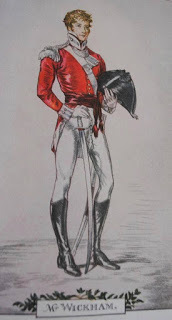 The recent discovery of George Wickham’s papers in circumstances as dramatic as any novel should rightly have been a cause célèbre. Perhaps mindful of the appropriation of the gentleman’s name and likeness by other authors over the years, however, the Wickham estate chose not to publicise this important discovery.
The recent discovery of George Wickham’s papers in circumstances as dramatic as any novel should rightly have been a cause célèbre. Perhaps mindful of the appropriation of the gentleman’s name and likeness by other authors over the years, however, the Wickham estate chose not to publicise this important discovery.The Mr Wickham that emerges from these pages is a man of no small confidence who was, it seems, blessed by fortune even as he faced privations, hardship and danger. His memoirs are those of a life well-lived but not of a life without challenges and can be read at Austen Variations; I do hope you enjoy them.
Published on November 12, 2016 02:54
November 8, 2016
The Rise of the Mantuamaker
I am thrilled to welcome Emma Tinkler-Hundal, the Georgian Seamstress, to the salon to discuss the wonderful clothes of the era!
---oOo---
The Rise of the Mantuamaker - By Emma Tinker-HundalUp until the turn of the 18th Century the tailor was the key figure associated with the construction of the outer garments of clothing for men and women. The lowly seamstress produced the shirts, chemises and other undergarments. During the late 17th and early 18th Century the Mantuamaker came into being, first in France as the law changed there in 1675 which allowed women to make women’s outerwear independent of the tailors. This new form of seamstress then spread across the channel but not without considerable problems from the tailor’s guilds that jealously guarded their monopoly.
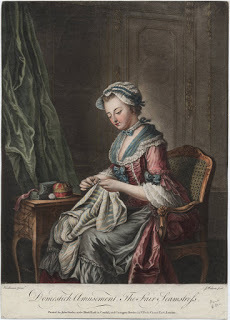 The encroachment of females into the male dominated province of tailoring was not the only revolutionary change that was happening in this period to the clothing industry. The production of readymade clothes was proliferating during this period, with London as the centre of its production; often by shop owners sending out piece work to legions of seamstresses; the majority of which spent their time in garrets sewing or in what can only be described as sweatshops doing piece work for a measly wage. The availability of readymade clothes was greater that you would expect in a time before the industrialisation and the invention of the sewing machine thanks to the hard work of hidden seamstresses. The wares produced were transported and sold across the country to people of all levels of society as well as large quantities for sailors and soldiers.
The encroachment of females into the male dominated province of tailoring was not the only revolutionary change that was happening in this period to the clothing industry. The production of readymade clothes was proliferating during this period, with London as the centre of its production; often by shop owners sending out piece work to legions of seamstresses; the majority of which spent their time in garrets sewing or in what can only be described as sweatshops doing piece work for a measly wage. The availability of readymade clothes was greater that you would expect in a time before the industrialisation and the invention of the sewing machine thanks to the hard work of hidden seamstresses. The wares produced were transported and sold across the country to people of all levels of society as well as large quantities for sailors and soldiers.
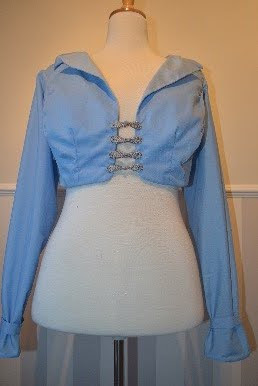 The tailor’s guilds tried to prevent the sale of readymade clothes as assiduously as they tried to stop the Mantuamakers; and for a time they succeeded in some towns and cities. Representatives from some of the guilds were sent to London to petition parliament numerous times and large quantities of money was expended by the guilds in petitioning parliament and prosecuting the readymade producers and sellers. Parliament in the end did not decide to support the guilds in keeping their monopoly, whether this was because of the numbers of women in gainful employment that wouldn’t have been without the clothing trade or because of the large quantities of readymade clothes that were constantly needed to clothe the Army and Navy is up for argument. What is for certain the failure of Parliament to do so set in motion the processes that would lead to the clothing trade that we have now.
The tailor’s guilds tried to prevent the sale of readymade clothes as assiduously as they tried to stop the Mantuamakers; and for a time they succeeded in some towns and cities. Representatives from some of the guilds were sent to London to petition parliament numerous times and large quantities of money was expended by the guilds in petitioning parliament and prosecuting the readymade producers and sellers. Parliament in the end did not decide to support the guilds in keeping their monopoly, whether this was because of the numbers of women in gainful employment that wouldn’t have been without the clothing trade or because of the large quantities of readymade clothes that were constantly needed to clothe the Army and Navy is up for argument. What is for certain the failure of Parliament to do so set in motion the processes that would lead to the clothing trade that we have now.
A bit about me:
The first reading of Pride and Prejudice at the age of twelve was a pivotal point and from then onwards the obsession hit. I not only fell in love with the romance between the protagonists, I fell in love with all things Regency. From Kings, Queens and the Court to the lives of ordinary people, from Medicine to Fashion, from the dark underground of Regency London to the lives of the demi-monde I devoured history books at an alarming rate and I found that nothing makes history come alive more than dressing up and living it. I may have been the only teenager that tried to create an ‘Elizabeth Bennet’ outfit using a summer dress and a bolero in order to go on long walks pretending I was her, but I doubt that I am. I have always enjoyed sewing and I have dabbled through the years but it was attending my first Regency ball that pushed me into attempting something as daunting as a regency ball gown.
I created my first gown and was surprised at how easy I found it and I haven’t stopped sewing since. I can no longer walk past a painting from the era without noting and taking apart the clothing they are wearing in my head and I positively salivate when actual extant clothes are displayed in exhibitions. I have expanded my skills to Millinery in order to make bonnets and Corsetry so I can make authentic underwear of the era. I have even dragged family members and friends into my obsession with my father creating hardwood busks for me so that I can make my own long stays.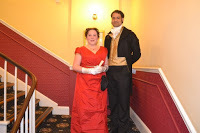 The culmination of all this obsessive sewing is the recent opening of my own shop on Etsy in which I am selling Handmade Regency Clothing and clothes from other eras. I plan to expand into earlier Georgian and Victorian in the near future.As to my obsession, I will continue to study all things Georgian and daydream about the past safe in the knowledge that if someone does invent a time machine, I will be suitably attired. https://www.etsy.com/uk/shop/AnotherEraByEmma
The culmination of all this obsessive sewing is the recent opening of my own shop on Etsy in which I am selling Handmade Regency Clothing and clothes from other eras. I plan to expand into earlier Georgian and Victorian in the near future.As to my obsession, I will continue to study all things Georgian and daydream about the past safe in the knowledge that if someone does invent a time machine, I will be suitably attired. https://www.etsy.com/uk/shop/AnotherEraByEmma
Further ReadingDress Culture and Commerce: The English Clothing Trade before the Factory 1660-1800, Beverly Lemire, ISBN 0-333-65204-5‘In the hands of work women’: English Markets, Cheap Clothing and Female labour, 1650-1800, Beverly Lemire (1999), Costume, 33:1, 23-35‘Sent from Town’: Commissioning Clothing in Britain During the Long Eighteenth Century, Miles Lambert, Costume, 43:1, 66-84
‘The New Dresses’: A Look at How Mantuamaking Became Established in Scotland, Elizabeth Sanderson, Costume, 35:1 14-23
this post copyright © Emma Tinkler-Hundal, 2016.
---oOo---
The Rise of the Mantuamaker - By Emma Tinker-HundalUp until the turn of the 18th Century the tailor was the key figure associated with the construction of the outer garments of clothing for men and women. The lowly seamstress produced the shirts, chemises and other undergarments. During the late 17th and early 18th Century the Mantuamaker came into being, first in France as the law changed there in 1675 which allowed women to make women’s outerwear independent of the tailors. This new form of seamstress then spread across the channel but not without considerable problems from the tailor’s guilds that jealously guarded their monopoly.
 The encroachment of females into the male dominated province of tailoring was not the only revolutionary change that was happening in this period to the clothing industry. The production of readymade clothes was proliferating during this period, with London as the centre of its production; often by shop owners sending out piece work to legions of seamstresses; the majority of which spent their time in garrets sewing or in what can only be described as sweatshops doing piece work for a measly wage. The availability of readymade clothes was greater that you would expect in a time before the industrialisation and the invention of the sewing machine thanks to the hard work of hidden seamstresses. The wares produced were transported and sold across the country to people of all levels of society as well as large quantities for sailors and soldiers.
The encroachment of females into the male dominated province of tailoring was not the only revolutionary change that was happening in this period to the clothing industry. The production of readymade clothes was proliferating during this period, with London as the centre of its production; often by shop owners sending out piece work to legions of seamstresses; the majority of which spent their time in garrets sewing or in what can only be described as sweatshops doing piece work for a measly wage. The availability of readymade clothes was greater that you would expect in a time before the industrialisation and the invention of the sewing machine thanks to the hard work of hidden seamstresses. The wares produced were transported and sold across the country to people of all levels of society as well as large quantities for sailors and soldiers. The tailor’s guilds tried to prevent the sale of readymade clothes as assiduously as they tried to stop the Mantuamakers; and for a time they succeeded in some towns and cities. Representatives from some of the guilds were sent to London to petition parliament numerous times and large quantities of money was expended by the guilds in petitioning parliament and prosecuting the readymade producers and sellers. Parliament in the end did not decide to support the guilds in keeping their monopoly, whether this was because of the numbers of women in gainful employment that wouldn’t have been without the clothing trade or because of the large quantities of readymade clothes that were constantly needed to clothe the Army and Navy is up for argument. What is for certain the failure of Parliament to do so set in motion the processes that would lead to the clothing trade that we have now.
The tailor’s guilds tried to prevent the sale of readymade clothes as assiduously as they tried to stop the Mantuamakers; and for a time they succeeded in some towns and cities. Representatives from some of the guilds were sent to London to petition parliament numerous times and large quantities of money was expended by the guilds in petitioning parliament and prosecuting the readymade producers and sellers. Parliament in the end did not decide to support the guilds in keeping their monopoly, whether this was because of the numbers of women in gainful employment that wouldn’t have been without the clothing trade or because of the large quantities of readymade clothes that were constantly needed to clothe the Army and Navy is up for argument. What is for certain the failure of Parliament to do so set in motion the processes that would lead to the clothing trade that we have now. A bit about me:
The first reading of Pride and Prejudice at the age of twelve was a pivotal point and from then onwards the obsession hit. I not only fell in love with the romance between the protagonists, I fell in love with all things Regency. From Kings, Queens and the Court to the lives of ordinary people, from Medicine to Fashion, from the dark underground of Regency London to the lives of the demi-monde I devoured history books at an alarming rate and I found that nothing makes history come alive more than dressing up and living it. I may have been the only teenager that tried to create an ‘Elizabeth Bennet’ outfit using a summer dress and a bolero in order to go on long walks pretending I was her, but I doubt that I am. I have always enjoyed sewing and I have dabbled through the years but it was attending my first Regency ball that pushed me into attempting something as daunting as a regency ball gown.

I created my first gown and was surprised at how easy I found it and I haven’t stopped sewing since. I can no longer walk past a painting from the era without noting and taking apart the clothing they are wearing in my head and I positively salivate when actual extant clothes are displayed in exhibitions. I have expanded my skills to Millinery in order to make bonnets and Corsetry so I can make authentic underwear of the era. I have even dragged family members and friends into my obsession with my father creating hardwood busks for me so that I can make my own long stays.
 The culmination of all this obsessive sewing is the recent opening of my own shop on Etsy in which I am selling Handmade Regency Clothing and clothes from other eras. I plan to expand into earlier Georgian and Victorian in the near future.As to my obsession, I will continue to study all things Georgian and daydream about the past safe in the knowledge that if someone does invent a time machine, I will be suitably attired. https://www.etsy.com/uk/shop/AnotherEraByEmma
The culmination of all this obsessive sewing is the recent opening of my own shop on Etsy in which I am selling Handmade Regency Clothing and clothes from other eras. I plan to expand into earlier Georgian and Victorian in the near future.As to my obsession, I will continue to study all things Georgian and daydream about the past safe in the knowledge that if someone does invent a time machine, I will be suitably attired. https://www.etsy.com/uk/shop/AnotherEraByEmmaFurther ReadingDress Culture and Commerce: The English Clothing Trade before the Factory 1660-1800, Beverly Lemire, ISBN 0-333-65204-5‘In the hands of work women’: English Markets, Cheap Clothing and Female labour, 1650-1800, Beverly Lemire (1999), Costume, 33:1, 23-35‘Sent from Town’: Commissioning Clothing in Britain During the Long Eighteenth Century, Miles Lambert, Costume, 43:1, 66-84
‘The New Dresses’: A Look at How Mantuamaking Became Established in Scotland, Elizabeth Sanderson, Costume, 35:1 14-23
this post copyright © Emma Tinkler-Hundal, 2016.
Published on November 08, 2016 16:00
November 3, 2016
The Romance of Reform
It's a delight to welcome Julia Justiss to the salon, to peer into the romance of reform!
---oOo---
Several years ago, I wrote FROM WAIF TO GENTLEMAN’S WIFE, set during a time of loom-breaking and Luddite riots, as those in the English countryside reacted to cheap factory cloth that was destroying the home-weaving industry and the sharp rise in bread prices caused by the French wars. When the heroine was threatened by the villain, a young farmer’s orphan helped the hero rescue her, earning Sir Edward Greaves’s gratitude and sponsorship. The character of the orphaned Davie captured me too; I knew he would grow up to be a politician who would help democratize the government of England, and that one day I would write his story.
So Davie became the nucleus of the group of four friends, dubbed “Hadley’s Hellions” after their leader, Giles Hadley, Viscount Lyndlington. All in some way outsiders from aristocratic British Society, they band together at Oxford with the goal of reforming Parliament, go on to the Commons, and work to craft the Great Reform Bill of 1832.
Of course, overriding the politics are love stories, as each Hellion finds the right lady to reform him and make his life complete. In Davie’s case, it is Faith Wellingford, the vivacious young beauty he falls in love with when he’s serving as Ned’s secretary. Sister of a marquess, she’s far beyond his touch, becoming even more so when she marries a duke. But Davie never stops loving her, and when she’s widowed ten years later, a chance meeting brings them back together, leading to STOLEN ENCOUNTERS WITH THE DUCHESS.
The political landscape of England certainly needed reform. Parliamentary districts and voting qualifications had been established under Henry IV in 1430-32, and changed little over the centuries. One of the most egregious inequities, and the first to be successfully addressed by Reform legislation, were “rotten boroughs.”
As one might expect, by the 1800’s there had considerable shifting of population. Some of the boroughs which had robust populations in the 1400’s had dwindled to mere hamlets, while the rapid growth spurred by the Industrial Revolution had created cities like Manchester and Liverpool in what had been woods and fields. These great cities had no representation in Parliament at all, while places like Dunwich (32 voters) Camelford (25) and Gatton (7) still sent a representative to Parliament.
Naturally, with so few voters and with the procedure of casting votes in public, it became easy for the most powerful landowner in the vicinity to “persuade” the voters to select the candidate he favored, or for the candidate to support the policies of the great local patron, less he risk not being returned to Parliament in the next election. Some of the great estates had several towns or boroughs near them, to the effect that, by the 1800’s, the Duke of Norfolk controlled eleven constituencies, the Earl of Lonsdale nine. Out of 514 members representing England, 370 were selected by 180 patrons.
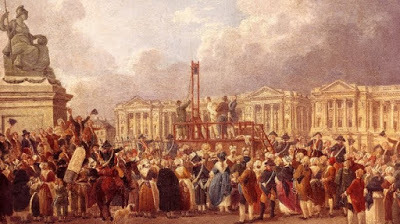
Efforts to reform these obvious inequities began in the latter 1700’s, but were derailed for half a century, not by English political differences, but by the French. Quite a few English politicians admired the principles upon which the French Revolution was based, but the horrors of the Terror, and then the belligerent expansion of the French Empire under Napoleon, so traumatized an English government worried about violent revolution at home that attempts at reform in Parliament were squelched and unrest in the countryside brutally put down.
Finally, by the end of the 1820’s, with the Napoleonic Wars won and the butchery of the Terror a fading memory, British politicians began to make progress toward real reform. After a new king succeeded “Prinny” (King George IV) in 1830, reform because the great issue of the ensuing parliamentary election. For the next two years, Parliament would swing between the two parties, Lord Wellington, the voice of Tory opposition, being voted in and out, with Lord Grey, the Whig leader, succeeding him in attempts to craft legislation that could pass both the Commons and the Lords.
In March of 1831, a reform committee of junior ministers (prototypes for my Hellions) drew up a bill for Lord Russell on behalf of government. It proposed to disfranchise 60 of the smallest boroughs and reduce representation of 47 others, abolishing some seats outright and transferring others to the London suburbs, large cities, counties, Scotland or Ireland. The bill also standardized and expanded borough franchise, increasing the size of the electorate. Although the bill passed its first reading in March, opponents created so many delays and diversions in committee that the government decided to dissolve Parliament and take the issue to the people in a new election.
A new, overwhelmingly reform-minded Parliament convened in June, and by the end of September, the Commons had passed the bill with a majority of more than 100. But one of the reforms envisioned was reducing or eliminating seats of the upper clergy in the House of Lords; under this threat, although many of the temporal lords reluctantly agreed to reform, the Lords Spiritual were able to muster enough of their members to defeat the bill on 7 October.
Upon news of the defeat, riots broke out in Bristol, Derby, Nottingham, Dorset, Leicestershire and Somerset. Mobs attacked the jail in Bristol and freed prisoners, destroyed the palace of the Bishop of Bristol, the mansion of the Lord Mayor, and several private homes. The country manors of the Duke of Newcastle and Lord Middleton were also attacked (such an attack is described in STOLEN ENCOUNTERS.)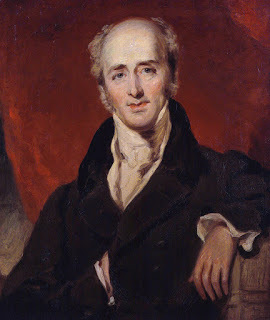 Lord Grey by Sir Thomas LawrenceSince the bill could not be re-introduced in the same session, the ministry advised the King to prorogue Parliament. A new Parliament convened in December, and by March 1832 the new Reform Bill passed the Commons with even larger majorities. When the Lords sought to delay the disenfranchisement of the rotten boroughs, Lord Grey urged the King to create enough new Lords to pass the bill. When he refused, Grey resigned and the King asked Wellington to return and form a new government.
Lord Grey by Sir Thomas LawrenceSince the bill could not be re-introduced in the same session, the ministry advised the King to prorogue Parliament. A new Parliament convened in December, and by March 1832 the new Reform Bill passed the Commons with even larger majorities. When the Lords sought to delay the disenfranchisement of the rotten boroughs, Lord Grey urged the King to create enough new Lords to pass the bill. When he refused, Grey resigned and the King asked Wellington to return and form a new government.
The result was the “Days of May,” political agitation so great, there was real fear of a revolution. Protestors advocated non-payment of taxes; there was a run on banks that saw l.8 million pounds withdrawn out of 7 million assets, and petitions were sent to the Commons demanding that it cut off funding to the government until the Lords acquiesced. There were even calls for the abolition of the aristocracy and the monarchy itself. Wellington was unable to form a government, and the King was forced to recall Grey.
The King reluctantly agreed to Grey’s demand that he appoint new peers to fill the House of Lords; however, before he did so, the King sent a private letter to all the members asking that they pass the bill so he would not have to do so. Enough opposing Lords abstained on the ensuing ballot that the bill finally passed, receiving royal approval on June 7, 1832.
The great task of modern reform had begun. Later modifications would see the abolition of slavery in 1833, further expansion of the electorate, and eventually, votes for women. But in the heady first years of the 1830’s, statesmen like my Hellions were able to push through the first significant reforms to the parliamentary system of government in four hundred years.
As an interesting side note, our Lord Grey of the Reform movement was also the fiery young Mr. Charles Grey who fell in love with Georgiana Cavendish, Duchess of Devonshire, became her lover, and urged her to leave the duke. Under threat from the Duke of losing access to her other children forever, Georgiana broke off with Grey. But she secretly bore him a daughter, Eliza Courtney, who was turned over to Grey’s parents to raise. He’s also the “Lord Grey” who devised the famous tea blend that still bears his name.
Read about Julia’s Hellions! Giles (FORBIDDEN NIGHTS WITH THE VISCOUNT) Davie (STOLEN ENCOUNTERS WITH THE DUCHESS) and Ben (CONVENIENT PROPOSAL TO A LADY, coming in March 2017.
STOLEN ENCOUNTERS WITH THE DUCHESS Faith Wellingford Evers, Duchess of Ashedon, is tired of society’s endless gossiping about her failings and her late husband’s infidelities. Seeking escape one night, she’s attacked by ruffians, but is saved by an unlikely figure from her past.
Faith Wellingford Evers, Duchess of Ashedon, is tired of society’s endless gossiping about her failings and her late husband’s infidelities. Seeking escape one night, she’s attacked by ruffians, but is saved by an unlikely figure from her past.
Having risen from penniless orphan to Member of Parliament, David Tanner Smith is no longer the quiet boy Faith once knew. With the first spine-tingling kiss, their old friendship is transformed. And in its place is an explosive mix of illicit encounters and forbidden desire…
About the Author
 Award-winning historical romance author Julia Justiss has written more than twenty-five novels and novellas set in the English Regency. Her awards include the Golden Heart for Regency from Romance Writers of America, The Golden Quill, and finals in Romantic Times Magazine’s Best First Historical, the National Readers Choice, the Daphne du Maurier and All About Romance’s Favorite Book of the Year.
Award-winning historical romance author Julia Justiss has written more than twenty-five novels and novellas set in the English Regency. Her awards include the Golden Heart for Regency from Romance Writers of America, The Golden Quill, and finals in Romantic Times Magazine’s Best First Historical, the National Readers Choice, the Daphne du Maurier and All About Romance’s Favorite Book of the Year.
A voracious reader who began jotting down plot ideas for Nancy Drew novels in her third grade spiral, Julia has published poetry and worked as a business journalist. An avid fan of Georgette Heyer, while unable to work a regular job when her husband was posted at the U.S Embassy in Tunisia, she decided to write her own Regency novel. And never looked back.
She and her husband live in East Texas, where she continues to craft the stories she loves. Check her website www.juliajustiss.com for her latest releases.
Written content of this post copyright © Julia Justiss, 2016.
---oOo---
Several years ago, I wrote FROM WAIF TO GENTLEMAN’S WIFE, set during a time of loom-breaking and Luddite riots, as those in the English countryside reacted to cheap factory cloth that was destroying the home-weaving industry and the sharp rise in bread prices caused by the French wars. When the heroine was threatened by the villain, a young farmer’s orphan helped the hero rescue her, earning Sir Edward Greaves’s gratitude and sponsorship. The character of the orphaned Davie captured me too; I knew he would grow up to be a politician who would help democratize the government of England, and that one day I would write his story.
So Davie became the nucleus of the group of four friends, dubbed “Hadley’s Hellions” after their leader, Giles Hadley, Viscount Lyndlington. All in some way outsiders from aristocratic British Society, they band together at Oxford with the goal of reforming Parliament, go on to the Commons, and work to craft the Great Reform Bill of 1832.
Of course, overriding the politics are love stories, as each Hellion finds the right lady to reform him and make his life complete. In Davie’s case, it is Faith Wellingford, the vivacious young beauty he falls in love with when he’s serving as Ned’s secretary. Sister of a marquess, she’s far beyond his touch, becoming even more so when she marries a duke. But Davie never stops loving her, and when she’s widowed ten years later, a chance meeting brings them back together, leading to STOLEN ENCOUNTERS WITH THE DUCHESS.
The political landscape of England certainly needed reform. Parliamentary districts and voting qualifications had been established under Henry IV in 1430-32, and changed little over the centuries. One of the most egregious inequities, and the first to be successfully addressed by Reform legislation, were “rotten boroughs.”
As one might expect, by the 1800’s there had considerable shifting of population. Some of the boroughs which had robust populations in the 1400’s had dwindled to mere hamlets, while the rapid growth spurred by the Industrial Revolution had created cities like Manchester and Liverpool in what had been woods and fields. These great cities had no representation in Parliament at all, while places like Dunwich (32 voters) Camelford (25) and Gatton (7) still sent a representative to Parliament.
Naturally, with so few voters and with the procedure of casting votes in public, it became easy for the most powerful landowner in the vicinity to “persuade” the voters to select the candidate he favored, or for the candidate to support the policies of the great local patron, less he risk not being returned to Parliament in the next election. Some of the great estates had several towns or boroughs near them, to the effect that, by the 1800’s, the Duke of Norfolk controlled eleven constituencies, the Earl of Lonsdale nine. Out of 514 members representing England, 370 were selected by 180 patrons.

Efforts to reform these obvious inequities began in the latter 1700’s, but were derailed for half a century, not by English political differences, but by the French. Quite a few English politicians admired the principles upon which the French Revolution was based, but the horrors of the Terror, and then the belligerent expansion of the French Empire under Napoleon, so traumatized an English government worried about violent revolution at home that attempts at reform in Parliament were squelched and unrest in the countryside brutally put down.
Finally, by the end of the 1820’s, with the Napoleonic Wars won and the butchery of the Terror a fading memory, British politicians began to make progress toward real reform. After a new king succeeded “Prinny” (King George IV) in 1830, reform because the great issue of the ensuing parliamentary election. For the next two years, Parliament would swing between the two parties, Lord Wellington, the voice of Tory opposition, being voted in and out, with Lord Grey, the Whig leader, succeeding him in attempts to craft legislation that could pass both the Commons and the Lords.
In March of 1831, a reform committee of junior ministers (prototypes for my Hellions) drew up a bill for Lord Russell on behalf of government. It proposed to disfranchise 60 of the smallest boroughs and reduce representation of 47 others, abolishing some seats outright and transferring others to the London suburbs, large cities, counties, Scotland or Ireland. The bill also standardized and expanded borough franchise, increasing the size of the electorate. Although the bill passed its first reading in March, opponents created so many delays and diversions in committee that the government decided to dissolve Parliament and take the issue to the people in a new election.
A new, overwhelmingly reform-minded Parliament convened in June, and by the end of September, the Commons had passed the bill with a majority of more than 100. But one of the reforms envisioned was reducing or eliminating seats of the upper clergy in the House of Lords; under this threat, although many of the temporal lords reluctantly agreed to reform, the Lords Spiritual were able to muster enough of their members to defeat the bill on 7 October.
Upon news of the defeat, riots broke out in Bristol, Derby, Nottingham, Dorset, Leicestershire and Somerset. Mobs attacked the jail in Bristol and freed prisoners, destroyed the palace of the Bishop of Bristol, the mansion of the Lord Mayor, and several private homes. The country manors of the Duke of Newcastle and Lord Middleton were also attacked (such an attack is described in STOLEN ENCOUNTERS.)
 Lord Grey by Sir Thomas LawrenceSince the bill could not be re-introduced in the same session, the ministry advised the King to prorogue Parliament. A new Parliament convened in December, and by March 1832 the new Reform Bill passed the Commons with even larger majorities. When the Lords sought to delay the disenfranchisement of the rotten boroughs, Lord Grey urged the King to create enough new Lords to pass the bill. When he refused, Grey resigned and the King asked Wellington to return and form a new government.
Lord Grey by Sir Thomas LawrenceSince the bill could not be re-introduced in the same session, the ministry advised the King to prorogue Parliament. A new Parliament convened in December, and by March 1832 the new Reform Bill passed the Commons with even larger majorities. When the Lords sought to delay the disenfranchisement of the rotten boroughs, Lord Grey urged the King to create enough new Lords to pass the bill. When he refused, Grey resigned and the King asked Wellington to return and form a new government.The result was the “Days of May,” political agitation so great, there was real fear of a revolution. Protestors advocated non-payment of taxes; there was a run on banks that saw l.8 million pounds withdrawn out of 7 million assets, and petitions were sent to the Commons demanding that it cut off funding to the government until the Lords acquiesced. There were even calls for the abolition of the aristocracy and the monarchy itself. Wellington was unable to form a government, and the King was forced to recall Grey.
The King reluctantly agreed to Grey’s demand that he appoint new peers to fill the House of Lords; however, before he did so, the King sent a private letter to all the members asking that they pass the bill so he would not have to do so. Enough opposing Lords abstained on the ensuing ballot that the bill finally passed, receiving royal approval on June 7, 1832.
The great task of modern reform had begun. Later modifications would see the abolition of slavery in 1833, further expansion of the electorate, and eventually, votes for women. But in the heady first years of the 1830’s, statesmen like my Hellions were able to push through the first significant reforms to the parliamentary system of government in four hundred years.
As an interesting side note, our Lord Grey of the Reform movement was also the fiery young Mr. Charles Grey who fell in love with Georgiana Cavendish, Duchess of Devonshire, became her lover, and urged her to leave the duke. Under threat from the Duke of losing access to her other children forever, Georgiana broke off with Grey. But she secretly bore him a daughter, Eliza Courtney, who was turned over to Grey’s parents to raise. He’s also the “Lord Grey” who devised the famous tea blend that still bears his name.
Read about Julia’s Hellions! Giles (FORBIDDEN NIGHTS WITH THE VISCOUNT) Davie (STOLEN ENCOUNTERS WITH THE DUCHESS) and Ben (CONVENIENT PROPOSAL TO A LADY, coming in March 2017.
STOLEN ENCOUNTERS WITH THE DUCHESS
 Faith Wellingford Evers, Duchess of Ashedon, is tired of society’s endless gossiping about her failings and her late husband’s infidelities. Seeking escape one night, she’s attacked by ruffians, but is saved by an unlikely figure from her past.
Faith Wellingford Evers, Duchess of Ashedon, is tired of society’s endless gossiping about her failings and her late husband’s infidelities. Seeking escape one night, she’s attacked by ruffians, but is saved by an unlikely figure from her past.Having risen from penniless orphan to Member of Parliament, David Tanner Smith is no longer the quiet boy Faith once knew. With the first spine-tingling kiss, their old friendship is transformed. And in its place is an explosive mix of illicit encounters and forbidden desire…
About the Author
 Award-winning historical romance author Julia Justiss has written more than twenty-five novels and novellas set in the English Regency. Her awards include the Golden Heart for Regency from Romance Writers of America, The Golden Quill, and finals in Romantic Times Magazine’s Best First Historical, the National Readers Choice, the Daphne du Maurier and All About Romance’s Favorite Book of the Year.
Award-winning historical romance author Julia Justiss has written more than twenty-five novels and novellas set in the English Regency. Her awards include the Golden Heart for Regency from Romance Writers of America, The Golden Quill, and finals in Romantic Times Magazine’s Best First Historical, the National Readers Choice, the Daphne du Maurier and All About Romance’s Favorite Book of the Year.A voracious reader who began jotting down plot ideas for Nancy Drew novels in her third grade spiral, Julia has published poetry and worked as a business journalist. An avid fan of Georgette Heyer, while unable to work a regular job when her husband was posted at the U.S Embassy in Tunisia, she decided to write her own Regency novel. And never looked back.
She and her husband live in East Texas, where she continues to craft the stories she loves. Check her website www.juliajustiss.com for her latest releases.
Written content of this post copyright © Julia Justiss, 2016.
Published on November 03, 2016 17:00
October 28, 2016
Letter from Ramsgate
It's my pleasure to welcome Suzan Lauder with a vignette from her new novel, Letter from Ramsgate! There's also a giveaway...
---oOo---
In honour of Madame Gilflurt’s personal relationship (oh, that sounds cheeky!) with Mr. Wickham from the 1995 BBC A&E Pride and Prejudice, I offer the readers an outtake from the original epilogue for Letter from Ramsgate. The newlywed Darcys are having a conversation about Mr. Wickham in July 1813.~~~
The History behind the VignetteEnos Collins (1774-1871) and Liverpool Packet are part of Nova Scotia history. (The separate colony joined Canada on Confederation in 1867.) The schooner had a reputation for speed and stealth and was used for mail and passenger transport during the first year Collins owned her. In October 1812, Collins obtained a marque which allowed her crew “to apprehend, seize and take any ship, vessel or goods belonging to the citizens of the United States or bearing the flag of said United States,” meaning Liverpool Packet was now a privateer. “The most dreaded Nova Scotian vessel to ply New England waters during the war [of 1812],” Liverpool Packet took 33 prizes under Captain Joseph Barss.Mr. Wickham’s “disappearance” took place on June 10, 1813 while Liverpool Packet was trying to capture the American privateer schooner Thomas.
Vignette
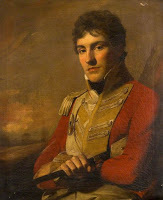 Darcy turned to gaze at Elizabeth. “You recall that George Wickham travelled to Nova Scotia and met the man who bought all his debts.”She nodded. Mr. Wickham was required to work to repay his debts, but had boasted his expectation to easily gain a great fortune in the lower colonies. “I am amused that the Nova Scotian fellow’s name is Mr. Collins. I do not think he is much like my cousin, though.”He smiled slightly as he glanced at her. “Not at all alike. Mr. Enos Collins is a millionaire in shipping.”The word was unusual—did it mean what she thought? “Millionaire?”“Yes, he has earned over a millions dollars, and founded a bank,” said Darcy. His gaze returned to the sea. “Wickham was keen to sail, and assumed he would travel as a gentleman passenger on a packet boat. But Mr. Enos Collins wanted him to learn a lesson, and tested Wickham by having him assigned all possible sorts of duties on the ship as he sailed from England to Nova Scotia. Instead, Wickham was insolent and haughty and expected to be treated like a gentleman.
Darcy turned to gaze at Elizabeth. “You recall that George Wickham travelled to Nova Scotia and met the man who bought all his debts.”She nodded. Mr. Wickham was required to work to repay his debts, but had boasted his expectation to easily gain a great fortune in the lower colonies. “I am amused that the Nova Scotian fellow’s name is Mr. Collins. I do not think he is much like my cousin, though.”He smiled slightly as he glanced at her. “Not at all alike. Mr. Enos Collins is a millionaire in shipping.”The word was unusual—did it mean what she thought? “Millionaire?”“Yes, he has earned over a millions dollars, and founded a bank,” said Darcy. His gaze returned to the sea. “Wickham was keen to sail, and assumed he would travel as a gentleman passenger on a packet boat. But Mr. Enos Collins wanted him to learn a lesson, and tested Wickham by having him assigned all possible sorts of duties on the ship as he sailed from England to Nova Scotia. Instead, Wickham was insolent and haughty and expected to be treated like a gentleman.
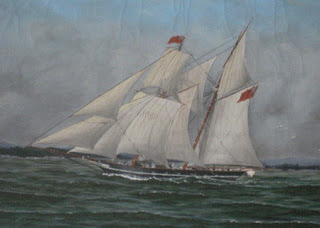 “Wickham did not even step on land when he arrived at Halifax harbour. Rather than employ him in business, Enos Collins sent Wickham back to sea until he could learn to do any task well without complaint. Wickham was moved to his fastest boat, a successful privateer schooner called Liverpool Packet.” Mr. Wickham would be employed on board a vessel assigned to capture American merchant ships and take their cargo as prizes on behalf of England. It amounted to legal piracy. “My! Mr. Wickham a war privateer. It suits!” His glare chastised. Something was not right. If her husband was unhappy about Mr. Wickham’s occupation, the story was not ended.Darcy’s accent had none of its usual sedateness. “In June, Liverpool Packet was attempting to overcome an American vessel, and shots were fired, killing three Americans. In the skirmish, the Americans were the victors and claimed Liverpool Packet and her crew. No one knows what happened to George Wickham.”
“Wickham did not even step on land when he arrived at Halifax harbour. Rather than employ him in business, Enos Collins sent Wickham back to sea until he could learn to do any task well without complaint. Wickham was moved to his fastest boat, a successful privateer schooner called Liverpool Packet.” Mr. Wickham would be employed on board a vessel assigned to capture American merchant ships and take their cargo as prizes on behalf of England. It amounted to legal piracy. “My! Mr. Wickham a war privateer. It suits!” His glare chastised. Something was not right. If her husband was unhappy about Mr. Wickham’s occupation, the story was not ended.Darcy’s accent had none of its usual sedateness. “In June, Liverpool Packet was attempting to overcome an American vessel, and shots were fired, killing three Americans. In the skirmish, the Americans were the victors and claimed Liverpool Packet and her crew. No one knows what happened to George Wickham.”
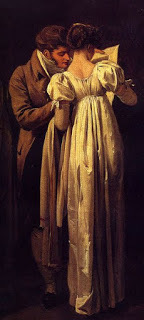 No wonder he was so concerned! Her husband hated the inability to solve this problem. He needed a reminder of how honour had not been enough to change Mr. Wickham. She touched his furrowed brow.“Fitzwilliam, you must not take this upon yourself. Mr. Wickham’s actions set his course. You are wonderful for caring so much, but in spite of your help, he has continued to create his own problems.”“You are right.” He huffed in frustration as he turned them back towards the house. “You know, I tried to give him another chance. I offered him work so he would not have to leave England. He laughed. He said I was small beer, and he associated with stronger brew now. Can you imagine my thoughts? Small beer! I am small beer!” The words were spat out in disgust.He did not deserve to feel so upset at Wickham’s disparagement. When would Mr. Wickham cease tormenting her husband? But her anger would not help right now. It was important to encourage him to remove his sense of responsibility from the problem he had not created.“If you must be small beer, then you are my small beer, and quite tasty. I can only add that it is a truth well known that there has never been such a handsome and kind beverage to be found.” She gave his arm a light squeeze and was rewarded with a small smirk.“Perhaps he does not deserve such a harsh fate, but it was his choice, as are all his previous problems. Heaven help me, Fitzwilliam, but I am grateful he is gone, because it is near impossible for him to trouble you any longer. It pains me when he disrespects you after all you have done for him. Let us resolve to never speak of him again.” It was a huge demand. Could he manage to do this?Darcy sighed. “I do not know that I can. I will try.”
No wonder he was so concerned! Her husband hated the inability to solve this problem. He needed a reminder of how honour had not been enough to change Mr. Wickham. She touched his furrowed brow.“Fitzwilliam, you must not take this upon yourself. Mr. Wickham’s actions set his course. You are wonderful for caring so much, but in spite of your help, he has continued to create his own problems.”“You are right.” He huffed in frustration as he turned them back towards the house. “You know, I tried to give him another chance. I offered him work so he would not have to leave England. He laughed. He said I was small beer, and he associated with stronger brew now. Can you imagine my thoughts? Small beer! I am small beer!” The words were spat out in disgust.He did not deserve to feel so upset at Wickham’s disparagement. When would Mr. Wickham cease tormenting her husband? But her anger would not help right now. It was important to encourage him to remove his sense of responsibility from the problem he had not created.“If you must be small beer, then you are my small beer, and quite tasty. I can only add that it is a truth well known that there has never been such a handsome and kind beverage to be found.” She gave his arm a light squeeze and was rewarded with a small smirk.“Perhaps he does not deserve such a harsh fate, but it was his choice, as are all his previous problems. Heaven help me, Fitzwilliam, but I am grateful he is gone, because it is near impossible for him to trouble you any longer. It pains me when he disrespects you after all you have done for him. Let us resolve to never speak of him again.” It was a huge demand. Could he manage to do this?Darcy sighed. “I do not know that I can. I will try.”
References: The Dictionary of Canadian Biography: Enos Collins thestar.com Joseph Barss: The Greatest of the Nova Scotia Privateers
Liverpool Packet on Wikipedia
~~~
About the Book:
Sir, I am not known to you. I fear you may have concerns regarding some intelligence that recently came to me from your sister......a simple letter shatters illusions and turns the world upside down!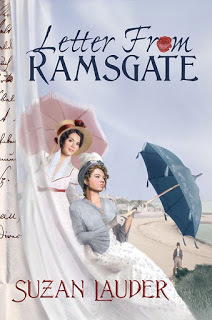 On holiday in Ramsgate, Elizabeth Bennet befriends shy, romantic Georgiana Darcy, who shares an adoring description of an ideal elder brother. When Georgiana discloses a secret infatuation with her brother’s “close friend” Mr. Wickham, Elizabeth’s altered perception of both men affects her actions and alliances.The secret within an anonymous letter from Ramsgate ties Mr. Darcy and Elizabeth together but also separates them. A second missive unlocks the disguise, but Mr. Darcy realizes his true passions too late to assist Elizabeth in her darkest hour. Will the shocking disclosure of a forgotten letter transform his understanding of her heart and lead them to embrace their future?Letter from Ramsgate is a Pride and Prejudice variation suitable for most audiences (youth and up).
On holiday in Ramsgate, Elizabeth Bennet befriends shy, romantic Georgiana Darcy, who shares an adoring description of an ideal elder brother. When Georgiana discloses a secret infatuation with her brother’s “close friend” Mr. Wickham, Elizabeth’s altered perception of both men affects her actions and alliances.The secret within an anonymous letter from Ramsgate ties Mr. Darcy and Elizabeth together but also separates them. A second missive unlocks the disguise, but Mr. Darcy realizes his true passions too late to assist Elizabeth in her darkest hour. Will the shocking disclosure of a forgotten letter transform his understanding of her heart and lead them to embrace their future?Letter from Ramsgate is a Pride and Prejudice variation suitable for most audiences (youth and up).
About the Author:
 A love for Jane Austen’s novels and Regency and Austenesque romance novels inspired Suzan Lauder to write her own variations, which led her to a passion for Regency era history and costuming, as well as social media book marketing. She cherishes the many friends she’s made as a result of these interests.Suzan is a member of JASNA, VIRA, RWA (PAN and Beau Monde chapters), and is a registered professional engineer. She enjoys independent travel, design, Pilates, yoga, cycling, sustainability, upcycling, architecture, beta editing, and blogging. Most of the time, a Vancouver Island penthouse loft condominium with a view of the Salish Sea is home. For a few months each winter, Mr. Suze and their two rescue cats accompany her to their tiny Spanish colonial casita in Centro Historico of an industrial city in Mexico.Letter from Ramsgate is Lauder’s second published novel and comes on the heels of her successful upcycled costuming blog series, the Thrift Shop Regency Costume Experiment. Her latest venture is blogging about her learning experiences while editing Letter from Ramsgate. Suzan’s first novel, Alias Thomas Bennet, is an Austen-inspired Regency romance with a mystery twist. She also contributed a short modern romance, Delivery Boy, to the holiday anthology Then Comes Winter. All Lauder’s published fiction is based on Pride and Prejudice and is available from Meryton Press.Website Goodreads Author Page Facebook Twitter Amazon Author Page Pinterest
A love for Jane Austen’s novels and Regency and Austenesque romance novels inspired Suzan Lauder to write her own variations, which led her to a passion for Regency era history and costuming, as well as social media book marketing. She cherishes the many friends she’s made as a result of these interests.Suzan is a member of JASNA, VIRA, RWA (PAN and Beau Monde chapters), and is a registered professional engineer. She enjoys independent travel, design, Pilates, yoga, cycling, sustainability, upcycling, architecture, beta editing, and blogging. Most of the time, a Vancouver Island penthouse loft condominium with a view of the Salish Sea is home. For a few months each winter, Mr. Suze and their two rescue cats accompany her to their tiny Spanish colonial casita in Centro Historico of an industrial city in Mexico.Letter from Ramsgate is Lauder’s second published novel and comes on the heels of her successful upcycled costuming blog series, the Thrift Shop Regency Costume Experiment. Her latest venture is blogging about her learning experiences while editing Letter from Ramsgate. Suzan’s first novel, Alias Thomas Bennet, is an Austen-inspired Regency romance with a mystery twist. She also contributed a short modern romance, Delivery Boy, to the holiday anthology Then Comes Winter. All Lauder’s published fiction is based on Pride and Prejudice and is available from Meryton Press.Website Goodreads Author Page Facebook Twitter Amazon Author Page Pinterest
Buy Links:Amazon
Blog Tour Schedule: 10/17 Guest Post, Excerpt, GA; My Jane Austen Book Club10/18 Excerpt, GA; Margie’s Must Reads10/19 Vignette, GA; Just Jane 181310/20 Review; From Pemberley to Milton10/21 Vignette, GA; Babblings of a Bookworm10/22 Excerpt, GA; Liz’s Reading Life10/23 Guest Post or Vignette, GA; From Pemberley to Milton10/24 Review; Tomorrow is Another Day10/25 Guest Post, Excerpt, GA; So little time…10/26 Vignette, GA; Austenesque Reviews10/27 Review, Excerpt; Half Agony, Half Hope10/28 Review; Diary of an Eccentric10/29 Guest Post; A Covent Garden Gilflurt’s Guide to Life10/30 Guest Post or Vignette, GA; More Agreeably Engaged
---oOo---
In honour of Madame Gilflurt’s personal relationship (oh, that sounds cheeky!) with Mr. Wickham from the 1995 BBC A&E Pride and Prejudice, I offer the readers an outtake from the original epilogue for Letter from Ramsgate. The newlywed Darcys are having a conversation about Mr. Wickham in July 1813.~~~
The History behind the VignetteEnos Collins (1774-1871) and Liverpool Packet are part of Nova Scotia history. (The separate colony joined Canada on Confederation in 1867.) The schooner had a reputation for speed and stealth and was used for mail and passenger transport during the first year Collins owned her. In October 1812, Collins obtained a marque which allowed her crew “to apprehend, seize and take any ship, vessel or goods belonging to the citizens of the United States or bearing the flag of said United States,” meaning Liverpool Packet was now a privateer. “The most dreaded Nova Scotian vessel to ply New England waters during the war [of 1812],” Liverpool Packet took 33 prizes under Captain Joseph Barss.Mr. Wickham’s “disappearance” took place on June 10, 1813 while Liverpool Packet was trying to capture the American privateer schooner Thomas.
Vignette
 Darcy turned to gaze at Elizabeth. “You recall that George Wickham travelled to Nova Scotia and met the man who bought all his debts.”She nodded. Mr. Wickham was required to work to repay his debts, but had boasted his expectation to easily gain a great fortune in the lower colonies. “I am amused that the Nova Scotian fellow’s name is Mr. Collins. I do not think he is much like my cousin, though.”He smiled slightly as he glanced at her. “Not at all alike. Mr. Enos Collins is a millionaire in shipping.”The word was unusual—did it mean what she thought? “Millionaire?”“Yes, he has earned over a millions dollars, and founded a bank,” said Darcy. His gaze returned to the sea. “Wickham was keen to sail, and assumed he would travel as a gentleman passenger on a packet boat. But Mr. Enos Collins wanted him to learn a lesson, and tested Wickham by having him assigned all possible sorts of duties on the ship as he sailed from England to Nova Scotia. Instead, Wickham was insolent and haughty and expected to be treated like a gentleman.
Darcy turned to gaze at Elizabeth. “You recall that George Wickham travelled to Nova Scotia and met the man who bought all his debts.”She nodded. Mr. Wickham was required to work to repay his debts, but had boasted his expectation to easily gain a great fortune in the lower colonies. “I am amused that the Nova Scotian fellow’s name is Mr. Collins. I do not think he is much like my cousin, though.”He smiled slightly as he glanced at her. “Not at all alike. Mr. Enos Collins is a millionaire in shipping.”The word was unusual—did it mean what she thought? “Millionaire?”“Yes, he has earned over a millions dollars, and founded a bank,” said Darcy. His gaze returned to the sea. “Wickham was keen to sail, and assumed he would travel as a gentleman passenger on a packet boat. But Mr. Enos Collins wanted him to learn a lesson, and tested Wickham by having him assigned all possible sorts of duties on the ship as he sailed from England to Nova Scotia. Instead, Wickham was insolent and haughty and expected to be treated like a gentleman.
 “Wickham did not even step on land when he arrived at Halifax harbour. Rather than employ him in business, Enos Collins sent Wickham back to sea until he could learn to do any task well without complaint. Wickham was moved to his fastest boat, a successful privateer schooner called Liverpool Packet.” Mr. Wickham would be employed on board a vessel assigned to capture American merchant ships and take their cargo as prizes on behalf of England. It amounted to legal piracy. “My! Mr. Wickham a war privateer. It suits!” His glare chastised. Something was not right. If her husband was unhappy about Mr. Wickham’s occupation, the story was not ended.Darcy’s accent had none of its usual sedateness. “In June, Liverpool Packet was attempting to overcome an American vessel, and shots were fired, killing three Americans. In the skirmish, the Americans were the victors and claimed Liverpool Packet and her crew. No one knows what happened to George Wickham.”
“Wickham did not even step on land when he arrived at Halifax harbour. Rather than employ him in business, Enos Collins sent Wickham back to sea until he could learn to do any task well without complaint. Wickham was moved to his fastest boat, a successful privateer schooner called Liverpool Packet.” Mr. Wickham would be employed on board a vessel assigned to capture American merchant ships and take their cargo as prizes on behalf of England. It amounted to legal piracy. “My! Mr. Wickham a war privateer. It suits!” His glare chastised. Something was not right. If her husband was unhappy about Mr. Wickham’s occupation, the story was not ended.Darcy’s accent had none of its usual sedateness. “In June, Liverpool Packet was attempting to overcome an American vessel, and shots were fired, killing three Americans. In the skirmish, the Americans were the victors and claimed Liverpool Packet and her crew. No one knows what happened to George Wickham.”
 No wonder he was so concerned! Her husband hated the inability to solve this problem. He needed a reminder of how honour had not been enough to change Mr. Wickham. She touched his furrowed brow.“Fitzwilliam, you must not take this upon yourself. Mr. Wickham’s actions set his course. You are wonderful for caring so much, but in spite of your help, he has continued to create his own problems.”“You are right.” He huffed in frustration as he turned them back towards the house. “You know, I tried to give him another chance. I offered him work so he would not have to leave England. He laughed. He said I was small beer, and he associated with stronger brew now. Can you imagine my thoughts? Small beer! I am small beer!” The words were spat out in disgust.He did not deserve to feel so upset at Wickham’s disparagement. When would Mr. Wickham cease tormenting her husband? But her anger would not help right now. It was important to encourage him to remove his sense of responsibility from the problem he had not created.“If you must be small beer, then you are my small beer, and quite tasty. I can only add that it is a truth well known that there has never been such a handsome and kind beverage to be found.” She gave his arm a light squeeze and was rewarded with a small smirk.“Perhaps he does not deserve such a harsh fate, but it was his choice, as are all his previous problems. Heaven help me, Fitzwilliam, but I am grateful he is gone, because it is near impossible for him to trouble you any longer. It pains me when he disrespects you after all you have done for him. Let us resolve to never speak of him again.” It was a huge demand. Could he manage to do this?Darcy sighed. “I do not know that I can. I will try.”
No wonder he was so concerned! Her husband hated the inability to solve this problem. He needed a reminder of how honour had not been enough to change Mr. Wickham. She touched his furrowed brow.“Fitzwilliam, you must not take this upon yourself. Mr. Wickham’s actions set his course. You are wonderful for caring so much, but in spite of your help, he has continued to create his own problems.”“You are right.” He huffed in frustration as he turned them back towards the house. “You know, I tried to give him another chance. I offered him work so he would not have to leave England. He laughed. He said I was small beer, and he associated with stronger brew now. Can you imagine my thoughts? Small beer! I am small beer!” The words were spat out in disgust.He did not deserve to feel so upset at Wickham’s disparagement. When would Mr. Wickham cease tormenting her husband? But her anger would not help right now. It was important to encourage him to remove his sense of responsibility from the problem he had not created.“If you must be small beer, then you are my small beer, and quite tasty. I can only add that it is a truth well known that there has never been such a handsome and kind beverage to be found.” She gave his arm a light squeeze and was rewarded with a small smirk.“Perhaps he does not deserve such a harsh fate, but it was his choice, as are all his previous problems. Heaven help me, Fitzwilliam, but I am grateful he is gone, because it is near impossible for him to trouble you any longer. It pains me when he disrespects you after all you have done for him. Let us resolve to never speak of him again.” It was a huge demand. Could he manage to do this?Darcy sighed. “I do not know that I can. I will try.”References: The Dictionary of Canadian Biography: Enos Collins thestar.com Joseph Barss: The Greatest of the Nova Scotia Privateers
Liverpool Packet on Wikipedia
~~~
About the Book:
Sir, I am not known to you. I fear you may have concerns regarding some intelligence that recently came to me from your sister......a simple letter shatters illusions and turns the world upside down!
 On holiday in Ramsgate, Elizabeth Bennet befriends shy, romantic Georgiana Darcy, who shares an adoring description of an ideal elder brother. When Georgiana discloses a secret infatuation with her brother’s “close friend” Mr. Wickham, Elizabeth’s altered perception of both men affects her actions and alliances.The secret within an anonymous letter from Ramsgate ties Mr. Darcy and Elizabeth together but also separates them. A second missive unlocks the disguise, but Mr. Darcy realizes his true passions too late to assist Elizabeth in her darkest hour. Will the shocking disclosure of a forgotten letter transform his understanding of her heart and lead them to embrace their future?Letter from Ramsgate is a Pride and Prejudice variation suitable for most audiences (youth and up).
On holiday in Ramsgate, Elizabeth Bennet befriends shy, romantic Georgiana Darcy, who shares an adoring description of an ideal elder brother. When Georgiana discloses a secret infatuation with her brother’s “close friend” Mr. Wickham, Elizabeth’s altered perception of both men affects her actions and alliances.The secret within an anonymous letter from Ramsgate ties Mr. Darcy and Elizabeth together but also separates them. A second missive unlocks the disguise, but Mr. Darcy realizes his true passions too late to assist Elizabeth in her darkest hour. Will the shocking disclosure of a forgotten letter transform his understanding of her heart and lead them to embrace their future?Letter from Ramsgate is a Pride and Prejudice variation suitable for most audiences (youth and up).
About the Author:
 A love for Jane Austen’s novels and Regency and Austenesque romance novels inspired Suzan Lauder to write her own variations, which led her to a passion for Regency era history and costuming, as well as social media book marketing. She cherishes the many friends she’s made as a result of these interests.Suzan is a member of JASNA, VIRA, RWA (PAN and Beau Monde chapters), and is a registered professional engineer. She enjoys independent travel, design, Pilates, yoga, cycling, sustainability, upcycling, architecture, beta editing, and blogging. Most of the time, a Vancouver Island penthouse loft condominium with a view of the Salish Sea is home. For a few months each winter, Mr. Suze and their two rescue cats accompany her to their tiny Spanish colonial casita in Centro Historico of an industrial city in Mexico.Letter from Ramsgate is Lauder’s second published novel and comes on the heels of her successful upcycled costuming blog series, the Thrift Shop Regency Costume Experiment. Her latest venture is blogging about her learning experiences while editing Letter from Ramsgate. Suzan’s first novel, Alias Thomas Bennet, is an Austen-inspired Regency romance with a mystery twist. She also contributed a short modern romance, Delivery Boy, to the holiday anthology Then Comes Winter. All Lauder’s published fiction is based on Pride and Prejudice and is available from Meryton Press.Website Goodreads Author Page Facebook Twitter Amazon Author Page Pinterest
A love for Jane Austen’s novels and Regency and Austenesque romance novels inspired Suzan Lauder to write her own variations, which led her to a passion for Regency era history and costuming, as well as social media book marketing. She cherishes the many friends she’s made as a result of these interests.Suzan is a member of JASNA, VIRA, RWA (PAN and Beau Monde chapters), and is a registered professional engineer. She enjoys independent travel, design, Pilates, yoga, cycling, sustainability, upcycling, architecture, beta editing, and blogging. Most of the time, a Vancouver Island penthouse loft condominium with a view of the Salish Sea is home. For a few months each winter, Mr. Suze and their two rescue cats accompany her to their tiny Spanish colonial casita in Centro Historico of an industrial city in Mexico.Letter from Ramsgate is Lauder’s second published novel and comes on the heels of her successful upcycled costuming blog series, the Thrift Shop Regency Costume Experiment. Her latest venture is blogging about her learning experiences while editing Letter from Ramsgate. Suzan’s first novel, Alias Thomas Bennet, is an Austen-inspired Regency romance with a mystery twist. She also contributed a short modern romance, Delivery Boy, to the holiday anthology Then Comes Winter. All Lauder’s published fiction is based on Pride and Prejudice and is available from Meryton Press.Website Goodreads Author Page Facebook Twitter Amazon Author Page Pinterest Buy Links:Amazon
Blog Tour Schedule: 10/17 Guest Post, Excerpt, GA; My Jane Austen Book Club10/18 Excerpt, GA; Margie’s Must Reads10/19 Vignette, GA; Just Jane 181310/20 Review; From Pemberley to Milton10/21 Vignette, GA; Babblings of a Bookworm10/22 Excerpt, GA; Liz’s Reading Life10/23 Guest Post or Vignette, GA; From Pemberley to Milton10/24 Review; Tomorrow is Another Day10/25 Guest Post, Excerpt, GA; So little time…10/26 Vignette, GA; Austenesque Reviews10/27 Review, Excerpt; Half Agony, Half Hope10/28 Review; Diary of an Eccentric10/29 Guest Post; A Covent Garden Gilflurt’s Guide to Life10/30 Guest Post or Vignette, GA; More Agreeably Engaged
Published on October 28, 2016 16:00
October 26, 2016
Researching Place for Historical Fiction – The Unseeing and 19th century London
I'm thrilled to welcome Anna Mazzola, author of the utterly magnificent The Unseeing to the salon; don't miss her fascinating post and her wonderful book!
---oOo---
Researching Place for Historical Fiction – The Unseeing and 19th century London
People often ask about how writers immerse themselves in the past, how they capture the spirit of the era and the location. Because that of course is absolutely essential to the success of a novel, especially a historical novel. When I think of the books I love, it is the ones that have taken me to another time and place and made me feel I was really there. So how do you create a world in which the reader will believe?
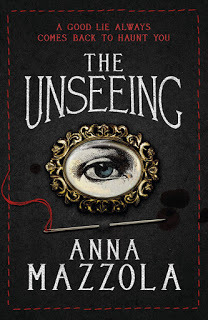 For me, the starting point is research, because I have to understand the world of my characters in order to write their story. The world of The Unseeing is the dark, stinking, corrupt London of 1837. Hannah Brown was murdered in December 1836, and Sarah Gale and James Greenacre were convicted in May 1837, a month before Victoria came to the throne. The Regency era is famous for its elegance, its fashions, its art and architecture, but beneath that lurked terrible poverty, rising crime, gambling, alcoholism and, of course, murder. In particular, The Unseeing’s world is that Newgate prison – the great stone fortress that once stood at the corner of Newgate Street and Old Bailey. Newgate was torn down in 1902, so there was no possibility of my stalking its gloomy corridors, but I read prison diaries and parliamentary commissions, I visited the real door at the Museum of London, I searched for sketches and pictures, and I studied plans of Newgate to get a sense of what that prison might have been like. The short answer is: horrific. An 1835 Committee referred to Newgate as a ‘stain’ on the character of the City of London; an institution, ‘which outrages the rights and feelings of humanity.’ By 1837, thanks largely to the work of social reformer Elizabeth Fry, conditions on the women’s side were less squalid than they had been earlier in the century. However, prisoners were still cold, ill and underfed, and many female prisoners had children with them, some only infants, all living together with hardened criminals and the mentally ill.
For me, the starting point is research, because I have to understand the world of my characters in order to write their story. The world of The Unseeing is the dark, stinking, corrupt London of 1837. Hannah Brown was murdered in December 1836, and Sarah Gale and James Greenacre were convicted in May 1837, a month before Victoria came to the throne. The Regency era is famous for its elegance, its fashions, its art and architecture, but beneath that lurked terrible poverty, rising crime, gambling, alcoholism and, of course, murder. In particular, The Unseeing’s world is that Newgate prison – the great stone fortress that once stood at the corner of Newgate Street and Old Bailey. Newgate was torn down in 1902, so there was no possibility of my stalking its gloomy corridors, but I read prison diaries and parliamentary commissions, I visited the real door at the Museum of London, I searched for sketches and pictures, and I studied plans of Newgate to get a sense of what that prison might have been like. The short answer is: horrific. An 1835 Committee referred to Newgate as a ‘stain’ on the character of the City of London; an institution, ‘which outrages the rights and feelings of humanity.’ By 1837, thanks largely to the work of social reformer Elizabeth Fry, conditions on the women’s side were less squalid than they had been earlier in the century. However, prisoners were still cold, ill and underfed, and many female prisoners had children with them, some only infants, all living together with hardened criminals and the mentally ill.
In order to try to understand the terror of confinement, I also read brilliant fiction set in prisons, institutions and concentration camps: Antonia Hodgson’s Devil in the Marshalsea, Andrew Hughes’ Convictions of John Delahunt, Alias Grace by Atwood, Affinity and Fingersmith by Sarah Waters, Gulag Archipelago, If This is a Man, The Last Day of a Condemned Man, Victor Hugo. And a lot of Dickens, who was fascinated by prisons and criminal justice in general, having witnessed as a child his father being imprisoned in the Marshalsea for debt. It helped that I had spent time in modern prisons (as a solicitor, rather than an inmate) and I lingered in other dark and enclosed places: a fortress in Portugal, a monk’s cell, a dungeon, to try and get a sense of what it must be like to be detained.
When it came to the streets of London outside the prison walls, I drew on various primary and secondary sources to try to establish what London might have looked, smelt and sounded like in the early 19th century: journalistic works such as Mayhew’s London Labour and the London Poor, the fiction of the period, guidebooks, newspaper reports, court reports, letters, and the journals and memoirs of those who lived in or visited London (also useful for establishing the voices of my characters). As I was researching mainly in the evenings after work, I conducted a large part of my research online and found priceless gems about Regency London at Harvard University and in the British Newspaper Archives. Forgotten Books (http://www.forgottenbooks.com) do a great line in out of print 19th century texts, Project Gutenberg has digitized versions of vast numbers of out-of-copyright books, and Google Books allows you access to snippets of various historical textbooks, legal journals and memoirs. There is also a wealth of recent books about London in the Regency and Victorian eras, for example Jerry White’s London In The Nineteenth Century: A Human Awful Wonder of God, Donald Low’s The Regency Underworld and Eliza Picard’s Victorian London.
As well as all this reading, I visited the places my characters did. I walked the same streets: Old Bailey, Inner Temple, Fleet Street, Hart Street. I found maps from the era and tried to imagine how the City would have looked. I also tried to envisage how the place had sounded and smelt – the cries of the hawkers, the street musicians, the stench of horse dung, wood smoke, fried fish.
Although much of the action in The Unseeing occurs in Newgate and the surrounding area, key scenes take place in Camberwell, South London. Indeed, that was the reason I first started reading about the murder: it took place not far from where I live. I visited Minet Library in Lambeth to look at old maps, and read reports, newspapers and books to glean a sense of what Camberwell might have been like at that time. It was, so far as I could deduce, a small village surrounded by fields, populated mainly by upper middle class families who considered the area healthier and more pleasant than the City, and who commuted to London by horse and carriage. However, there were also poorer areas, notably the slums off Bowyer Lane in Walworth. James Greenacre lived nearby with Sarah Gale, on Windmill Street (now Wyndham Road). It was here that Hannah Brown was killed. After the murder, the landlord gave guided tours of the house, which proved so popular that the police had to be brought in to stop visitors removing relics of the crime – tables, chairs, even the door.
And of course there came a point where I had to stop myself from researching and finish the darned book. I had to remind myself that I am not a historian – I am a writer, blending together research and imagination to form a different kind of truth. I had to weed out all of the fascinating historical details that in fact did nothing to drive the narrative forward, and accept that the vast majority of the research I had done would reside only in the back my mind and in the files of my computer. Like all writers of historical fiction, I had to learn the most difficult part of the research process: how to leave it all behind and write the story.
About the author:
Anna writes historical crime fiction and strange short stories. Her debut novel, The Unseeing, was published by Tinder Press (Headline) in July will be released in paperback in January 2017 (February in the US). Anna studied English at Oxford before becoming a criminal justice solicitor. She lives in Camberwell, not far from where the murder in The Unseeing took place, and divides her time between writing, reading, lawyering, and child-wrangling.
Website and social media links:
http://annamazzola.comhttps://twitter.com/Anna_Mazzhttps://www.facebook.com/AnnaMazzolaWriter/https://www.instagram.com/annamazzola...
Written content of this post copyright © Anna Mazzola, 2016.
---oOo---
Researching Place for Historical Fiction – The Unseeing and 19th century London
People often ask about how writers immerse themselves in the past, how they capture the spirit of the era and the location. Because that of course is absolutely essential to the success of a novel, especially a historical novel. When I think of the books I love, it is the ones that have taken me to another time and place and made me feel I was really there. So how do you create a world in which the reader will believe?
 For me, the starting point is research, because I have to understand the world of my characters in order to write their story. The world of The Unseeing is the dark, stinking, corrupt London of 1837. Hannah Brown was murdered in December 1836, and Sarah Gale and James Greenacre were convicted in May 1837, a month before Victoria came to the throne. The Regency era is famous for its elegance, its fashions, its art and architecture, but beneath that lurked terrible poverty, rising crime, gambling, alcoholism and, of course, murder. In particular, The Unseeing’s world is that Newgate prison – the great stone fortress that once stood at the corner of Newgate Street and Old Bailey. Newgate was torn down in 1902, so there was no possibility of my stalking its gloomy corridors, but I read prison diaries and parliamentary commissions, I visited the real door at the Museum of London, I searched for sketches and pictures, and I studied plans of Newgate to get a sense of what that prison might have been like. The short answer is: horrific. An 1835 Committee referred to Newgate as a ‘stain’ on the character of the City of London; an institution, ‘which outrages the rights and feelings of humanity.’ By 1837, thanks largely to the work of social reformer Elizabeth Fry, conditions on the women’s side were less squalid than they had been earlier in the century. However, prisoners were still cold, ill and underfed, and many female prisoners had children with them, some only infants, all living together with hardened criminals and the mentally ill.
For me, the starting point is research, because I have to understand the world of my characters in order to write their story. The world of The Unseeing is the dark, stinking, corrupt London of 1837. Hannah Brown was murdered in December 1836, and Sarah Gale and James Greenacre were convicted in May 1837, a month before Victoria came to the throne. The Regency era is famous for its elegance, its fashions, its art and architecture, but beneath that lurked terrible poverty, rising crime, gambling, alcoholism and, of course, murder. In particular, The Unseeing’s world is that Newgate prison – the great stone fortress that once stood at the corner of Newgate Street and Old Bailey. Newgate was torn down in 1902, so there was no possibility of my stalking its gloomy corridors, but I read prison diaries and parliamentary commissions, I visited the real door at the Museum of London, I searched for sketches and pictures, and I studied plans of Newgate to get a sense of what that prison might have been like. The short answer is: horrific. An 1835 Committee referred to Newgate as a ‘stain’ on the character of the City of London; an institution, ‘which outrages the rights and feelings of humanity.’ By 1837, thanks largely to the work of social reformer Elizabeth Fry, conditions on the women’s side were less squalid than they had been earlier in the century. However, prisoners were still cold, ill and underfed, and many female prisoners had children with them, some only infants, all living together with hardened criminals and the mentally ill. In order to try to understand the terror of confinement, I also read brilliant fiction set in prisons, institutions and concentration camps: Antonia Hodgson’s Devil in the Marshalsea, Andrew Hughes’ Convictions of John Delahunt, Alias Grace by Atwood, Affinity and Fingersmith by Sarah Waters, Gulag Archipelago, If This is a Man, The Last Day of a Condemned Man, Victor Hugo. And a lot of Dickens, who was fascinated by prisons and criminal justice in general, having witnessed as a child his father being imprisoned in the Marshalsea for debt. It helped that I had spent time in modern prisons (as a solicitor, rather than an inmate) and I lingered in other dark and enclosed places: a fortress in Portugal, a monk’s cell, a dungeon, to try and get a sense of what it must be like to be detained.
When it came to the streets of London outside the prison walls, I drew on various primary and secondary sources to try to establish what London might have looked, smelt and sounded like in the early 19th century: journalistic works such as Mayhew’s London Labour and the London Poor, the fiction of the period, guidebooks, newspaper reports, court reports, letters, and the journals and memoirs of those who lived in or visited London (also useful for establishing the voices of my characters). As I was researching mainly in the evenings after work, I conducted a large part of my research online and found priceless gems about Regency London at Harvard University and in the British Newspaper Archives. Forgotten Books (http://www.forgottenbooks.com) do a great line in out of print 19th century texts, Project Gutenberg has digitized versions of vast numbers of out-of-copyright books, and Google Books allows you access to snippets of various historical textbooks, legal journals and memoirs. There is also a wealth of recent books about London in the Regency and Victorian eras, for example Jerry White’s London In The Nineteenth Century: A Human Awful Wonder of God, Donald Low’s The Regency Underworld and Eliza Picard’s Victorian London.
As well as all this reading, I visited the places my characters did. I walked the same streets: Old Bailey, Inner Temple, Fleet Street, Hart Street. I found maps from the era and tried to imagine how the City would have looked. I also tried to envisage how the place had sounded and smelt – the cries of the hawkers, the street musicians, the stench of horse dung, wood smoke, fried fish.
Although much of the action in The Unseeing occurs in Newgate and the surrounding area, key scenes take place in Camberwell, South London. Indeed, that was the reason I first started reading about the murder: it took place not far from where I live. I visited Minet Library in Lambeth to look at old maps, and read reports, newspapers and books to glean a sense of what Camberwell might have been like at that time. It was, so far as I could deduce, a small village surrounded by fields, populated mainly by upper middle class families who considered the area healthier and more pleasant than the City, and who commuted to London by horse and carriage. However, there were also poorer areas, notably the slums off Bowyer Lane in Walworth. James Greenacre lived nearby with Sarah Gale, on Windmill Street (now Wyndham Road). It was here that Hannah Brown was killed. After the murder, the landlord gave guided tours of the house, which proved so popular that the police had to be brought in to stop visitors removing relics of the crime – tables, chairs, even the door.
And of course there came a point where I had to stop myself from researching and finish the darned book. I had to remind myself that I am not a historian – I am a writer, blending together research and imagination to form a different kind of truth. I had to weed out all of the fascinating historical details that in fact did nothing to drive the narrative forward, and accept that the vast majority of the research I had done would reside only in the back my mind and in the files of my computer. Like all writers of historical fiction, I had to learn the most difficult part of the research process: how to leave it all behind and write the story.
About the author:
Anna writes historical crime fiction and strange short stories. Her debut novel, The Unseeing, was published by Tinder Press (Headline) in July will be released in paperback in January 2017 (February in the US). Anna studied English at Oxford before becoming a criminal justice solicitor. She lives in Camberwell, not far from where the murder in The Unseeing took place, and divides her time between writing, reading, lawyering, and child-wrangling.
Website and social media links:
http://annamazzola.comhttps://twitter.com/Anna_Mazzhttps://www.facebook.com/AnnaMazzolaWriter/https://www.instagram.com/annamazzola...
Written content of this post copyright © Anna Mazzola, 2016.
Published on October 26, 2016 16:00
October 25, 2016
Strange Pathways
It's my pleasure to welcome Linda Strattman to the salon today, with a fascinating look into spiritualism, by way of a Brighton detour...
---oOo---
Research, even for a work of fiction, can lead one down some very strange paths. When I first thought of writing a series set in Victorian Brighton about a young woman who debunks fraudulent spirit mediums, I hadn’t expected to be exploring the history of conjuring, early treatments for scoliosis, medicated vapour baths, chess automata, and the wallpaper in the Royal Pavilion, but so it proved.
It is essential for me when setting a novel in the past, to understand the thoughts and beliefs of the time, and I read as much contemporary material as possible; books, periodicals, letters, diaries, records of public meetings, trials and inquests. This is where I can hear the people of the past speak. Some reveal their inner thoughts and conflicts, their struggles and discontent; others accept with varying degrees of success, the role that society has given them, and portray themselves as conforming to that role.
A good place to start one’s research in any area, however, is with a general overview of the field. The most useful will list references to follow up and also provide the important names and themes. Any history of spiritualism, however, should be approached with caution, since it will be written with the particular viewpoint and bias of the author. It is a field which invokes powerful emotions and beliefs. I have read works by dedicated spiritualists and by determined opponents. Balance is vital.
Sir Arthur Conan Doyle’s History of Spiritualism is as may be imagined, one of the more readable, and this led me to follow up the histories of the mystics and mediums in whom he believed so passionately. Many of the mediums were caught out in fraud or confessed it well before Doyle wrote his history, but despite this, he continued to champion them. To read Doyle’s writings on spiritualism is to gain an insight into the minds of devoted believers, how they described their experiences, and explained manifestations, failures, and the exposure of practitioners by skeptic.
 The author with the statue of Captain Pechell
The author with the statue of Captain Pechell
Closely tied in with the history of spiritualism is that of conjuring, since the techniques of stage magicians and fraudulent mediums are very similar. Only a few years ago, I would have had to spend many hours in the British Library making notes on the volumes I needed to read, but my first port of call is now the website archive.org, which provides scans of vast numbers of out of copyright works from reference libraries. In writing Mr Scarletti’s Ghost, a book which includes numerous seances, it was very important in every case for me to know exactly how the manifestations I described were produced. From time to time I do provide hints for the reader, rather than explicit explanations.
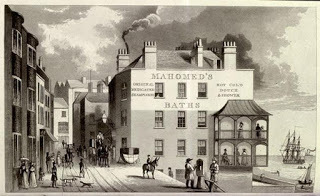 Steam baths in Brighton
Steam baths in Brighton
Creating a strong independent heroine in a historical context presents some challenges. As with Frances Doughty in my Bayswater series, I didn’t want to go down the easy route of making her rich, titled or beautiful. I like a woman who can battle against the odds! Mina Scarletti, the heroine of my Brighton series is a diminutive lady — even smaller than me, 4ft 8in to my 4ft 11in. She is disabled by scoliosis, but has enough spirit and determination for ten people. One reviewer described her as a ‘pocket rocket.’ Having been told that marriage and children are not advisable she decides to live her life to the fullest of her abilities, and finds ways of using what might be seen as a restriction to her advantage. Mina has survived being told that her condition is her own fault, survived being encased in plaster and metal, and has fortunately escaped dangerous surgery. She is her own woman, resolute and courageous.
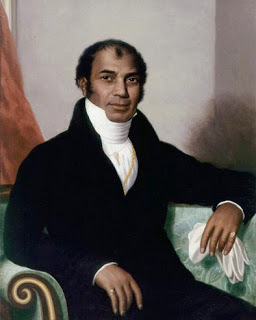 Sake Dean Mahomed
Sake Dean Mahomed
Setting my series in Brighton was one of my better decisions. Here is a town with a rich history, it’s own unique character, and a reputation as a place for regaining one’s health, which led it to be regarded as in itself, a doctor. The character of Dr Hamid who runs a therapeutic bath-house was inspired by Sake Dean Mahomed the Anglo-Indian surgeon who opened the first ‘Indian Medicated Vapour Bath’ in Brighton in 1814. Born in Bengal, he came to London in 1810 where he opened the first curry house in Britain. It wasn’t successful but clearly he started a trend!
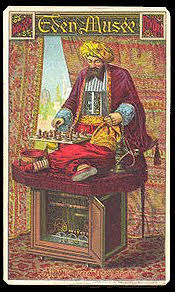 Ajeeb the chess automaton
Ajeeb the chess automaton
For my second book in the Mina Scarletti series I delved into the history of the Royal Pavilion during its early development, its royal heyday and its use as a Victorian place of entertainment. The Royal Ghost begins in 1871 with scandalous rumours of a sighting of the ghosts (dare one say the grey shades) of the Prince Regent and Mrs Fitzherbert enjoying each other’s company in a room where dragons and serpents writhe sensuously on red wallpaper. The vestibule is dominated by the sandstone statue of a deceased Crimean War hero, Captain Pechell; in another apartment, a chess automaton, the wondrous Ajeeb, towers over visitors like Frankenstein’s monster, while in the banqueting hall, an illusionist performs his famous Japanese butterfly trick. The scene is set for an invocation of the sprits.
Linda Stratmannwww.lindastratmann.com
Written content of this post copyright © Linda Stratmann, 2016.
---oOo---
Research, even for a work of fiction, can lead one down some very strange paths. When I first thought of writing a series set in Victorian Brighton about a young woman who debunks fraudulent spirit mediums, I hadn’t expected to be exploring the history of conjuring, early treatments for scoliosis, medicated vapour baths, chess automata, and the wallpaper in the Royal Pavilion, but so it proved.
It is essential for me when setting a novel in the past, to understand the thoughts and beliefs of the time, and I read as much contemporary material as possible; books, periodicals, letters, diaries, records of public meetings, trials and inquests. This is where I can hear the people of the past speak. Some reveal their inner thoughts and conflicts, their struggles and discontent; others accept with varying degrees of success, the role that society has given them, and portray themselves as conforming to that role.
A good place to start one’s research in any area, however, is with a general overview of the field. The most useful will list references to follow up and also provide the important names and themes. Any history of spiritualism, however, should be approached with caution, since it will be written with the particular viewpoint and bias of the author. It is a field which invokes powerful emotions and beliefs. I have read works by dedicated spiritualists and by determined opponents. Balance is vital.
Sir Arthur Conan Doyle’s History of Spiritualism is as may be imagined, one of the more readable, and this led me to follow up the histories of the mystics and mediums in whom he believed so passionately. Many of the mediums were caught out in fraud or confessed it well before Doyle wrote his history, but despite this, he continued to champion them. To read Doyle’s writings on spiritualism is to gain an insight into the minds of devoted believers, how they described their experiences, and explained manifestations, failures, and the exposure of practitioners by skeptic.
 The author with the statue of Captain Pechell
The author with the statue of Captain PechellClosely tied in with the history of spiritualism is that of conjuring, since the techniques of stage magicians and fraudulent mediums are very similar. Only a few years ago, I would have had to spend many hours in the British Library making notes on the volumes I needed to read, but my first port of call is now the website archive.org, which provides scans of vast numbers of out of copyright works from reference libraries. In writing Mr Scarletti’s Ghost, a book which includes numerous seances, it was very important in every case for me to know exactly how the manifestations I described were produced. From time to time I do provide hints for the reader, rather than explicit explanations.
 Steam baths in Brighton
Steam baths in BrightonCreating a strong independent heroine in a historical context presents some challenges. As with Frances Doughty in my Bayswater series, I didn’t want to go down the easy route of making her rich, titled or beautiful. I like a woman who can battle against the odds! Mina Scarletti, the heroine of my Brighton series is a diminutive lady — even smaller than me, 4ft 8in to my 4ft 11in. She is disabled by scoliosis, but has enough spirit and determination for ten people. One reviewer described her as a ‘pocket rocket.’ Having been told that marriage and children are not advisable she decides to live her life to the fullest of her abilities, and finds ways of using what might be seen as a restriction to her advantage. Mina has survived being told that her condition is her own fault, survived being encased in plaster and metal, and has fortunately escaped dangerous surgery. She is her own woman, resolute and courageous.
 Sake Dean Mahomed
Sake Dean MahomedSetting my series in Brighton was one of my better decisions. Here is a town with a rich history, it’s own unique character, and a reputation as a place for regaining one’s health, which led it to be regarded as in itself, a doctor. The character of Dr Hamid who runs a therapeutic bath-house was inspired by Sake Dean Mahomed the Anglo-Indian surgeon who opened the first ‘Indian Medicated Vapour Bath’ in Brighton in 1814. Born in Bengal, he came to London in 1810 where he opened the first curry house in Britain. It wasn’t successful but clearly he started a trend!
 Ajeeb the chess automaton
Ajeeb the chess automatonFor my second book in the Mina Scarletti series I delved into the history of the Royal Pavilion during its early development, its royal heyday and its use as a Victorian place of entertainment. The Royal Ghost begins in 1871 with scandalous rumours of a sighting of the ghosts (dare one say the grey shades) of the Prince Regent and Mrs Fitzherbert enjoying each other’s company in a room where dragons and serpents writhe sensuously on red wallpaper. The vestibule is dominated by the sandstone statue of a deceased Crimean War hero, Captain Pechell; in another apartment, a chess automaton, the wondrous Ajeeb, towers over visitors like Frankenstein’s monster, while in the banqueting hall, an illusionist performs his famous Japanese butterfly trick. The scene is set for an invocation of the sprits.
Linda Stratmannwww.lindastratmann.com
Written content of this post copyright © Linda Stratmann, 2016.
Published on October 25, 2016 16:00
October 18, 2016
Mirow: A Village Full of Castles
I'm delighted to welcome Julia Meister, who is your guide to Mirow!
---oOo---
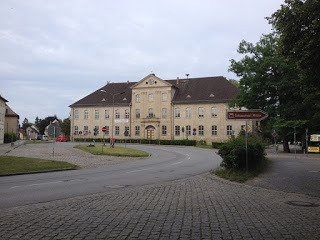 The Lower CastleMirow is a small, sleepy German village located in the Southern part of Mecklenburg-Vorpommern. With its 400 inhabitants and rural atmosphere, all one expects to find there is nature and, since it’s located within the Mecklenburgische Seenplatte (a region famous for its many lakes), a lake or two. There is – albeit in a positive way! – nothing regal about Mirow, until, that is, one approaches Mirow’s very own Castle Island. Before one even sets foot on it, one is surprised to discover that the building located right next to the island was once a beautiful castle. Beautiful enough even to be deemed appropriate as the place of birth for a princess belonging to the House of Mecklenburg-Strelitz, who ruled a small duchy in the North of Germany (another famous member of the Mecklenburg-Strelitz clan was Louise of Prussia, to whom we’ll come in another blog post!). After all, the little girl, born as Sophia Charlotte on May 19th, 1744 in the aforementioned castle (called the “Lower Castle”) in Mirow, was to become one of Britain’s royal leading ladies as the wife of King George III. Looking at the castle as it is now, it is hard to imagine its grandeur during the 18th Century. From the early 19th Century until 2006, it was used as a school. Sadly, it is now vacant and in dire need of renovation!
The Lower CastleMirow is a small, sleepy German village located in the Southern part of Mecklenburg-Vorpommern. With its 400 inhabitants and rural atmosphere, all one expects to find there is nature and, since it’s located within the Mecklenburgische Seenplatte (a region famous for its many lakes), a lake or two. There is – albeit in a positive way! – nothing regal about Mirow, until, that is, one approaches Mirow’s very own Castle Island. Before one even sets foot on it, one is surprised to discover that the building located right next to the island was once a beautiful castle. Beautiful enough even to be deemed appropriate as the place of birth for a princess belonging to the House of Mecklenburg-Strelitz, who ruled a small duchy in the North of Germany (another famous member of the Mecklenburg-Strelitz clan was Louise of Prussia, to whom we’ll come in another blog post!). After all, the little girl, born as Sophia Charlotte on May 19th, 1744 in the aforementioned castle (called the “Lower Castle”) in Mirow, was to become one of Britain’s royal leading ladies as the wife of King George III. Looking at the castle as it is now, it is hard to imagine its grandeur during the 18th Century. From the early 19th Century until 2006, it was used as a school. Sadly, it is now vacant and in dire need of renovation!

Moving on towards the actual Castle Island, one passes through a beautiful English landscape garden full of lush green trees. Hence, even judged by its surroundings, the Upper Castle seems much more worthy of royalty. This is due to the fact that a lot more care and effort is put into it, with lots of renovation going on inside. Built at the beginning of the 18th Century, it was mainly used as a widow’s seat by Duchess Elisabeth Albertine of Saxe-Hildburghausen, who was also a Duchess of Mecklenburg-Mirow. The Upper Castle is open to visitors, who can take a look at Mirow’s famous hand-stitched tapestry from the 18th Century, as well as its magnificent Baroque hall. The castle also features in-depth information on its former inhabitants, as well as, of course, Queen Charlotte. Since the castle is located in a small village, one can often pass through its halls without the distraction of many other visitors: I had this experience one, and it made me almost feel like the hostess of the castle myself!
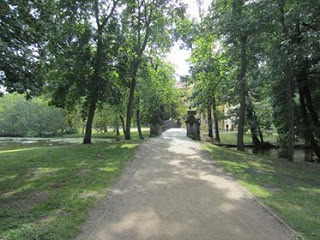 The park and the bridge connecting Mirow's Castle Island to Love IslandI highly recommend visiting the so-called Love Island, which can be reached via bridge, and from where one has a beautiful view of the Mirower See (the Castle Island’s very own lake). What makes it even more special is the grave of Adolf Friedrich VI., who was the last Grand Duke of Mecklenburg-Strelitz. He died in 1918 under mysterious circumstances: To this day, no one has ever really managed to find out whether he was murdered or committed suicide. This lack of clarity regarding his end lends a very special atmosphere to Mirow’s Love Island (and also makes one think that the name ‘Love Island’ and the fact that his tomb was placed here make for an interesting juxtaposition!).
The park and the bridge connecting Mirow's Castle Island to Love IslandI highly recommend visiting the so-called Love Island, which can be reached via bridge, and from where one has a beautiful view of the Mirower See (the Castle Island’s very own lake). What makes it even more special is the grave of Adolf Friedrich VI., who was the last Grand Duke of Mecklenburg-Strelitz. He died in 1918 under mysterious circumstances: To this day, no one has ever really managed to find out whether he was murdered or committed suicide. This lack of clarity regarding his end lends a very special atmosphere to Mirow’s Love Island (and also makes one think that the name ‘Love Island’ and the fact that his tomb was placed here make for an interesting juxtaposition!).
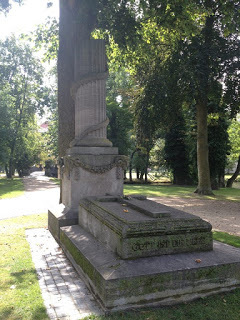 The grave of Adolf Friedrich VI
The grave of Adolf Friedrich VI
Another gem to be found on Mirow’s Castle Island is the Protestant Lutheran Church, once the castle church of the House of Mecklenburg-Strelitz. Make sure you visit the so-called Fürstengruft, the crypt where members of the Mecklenburg-Strelitz dynasty were laid to rest. One can catch a glimpse of 22 coffins, and it really gives one the shivers to be stood there in front of (unfortunately, deceased) royalty! The coffin of Duchess Elisabeth Albertine of Saxe-Hildburghausen, Mirow’s longest inhabitant, can be found here. Another famous figure that can be found amongst the dead in the crypt is Landgravine Charlotte of Hesse-Darmstadt, who was brought up with Marie Antoinette at the Imperial Court in Vienna. The two of them kept up a lifelong correspondence as pen pals.
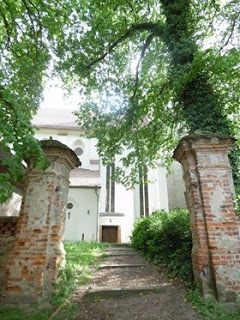 The steps leading up to the church
The steps leading up to the church
Mirow is very old-fashioned when it comes to public transport, and that’s what makes it even more charming: To get from Neustrelitz (the last train station you can reach via Deutsche Bahn) to Mirow, one has to travel by lovely little trains, known to insiders as railbuses. They have quite a cult following, and are still used by a train company in that area. While these railbuses may not date back to the times of Queen Charlotte, they certainly make getting to Mirow a rather nostalgic experience!
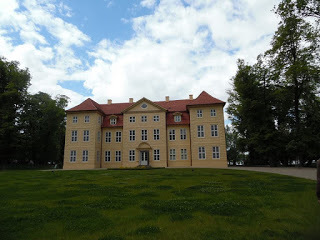 Mirow Castle
Mirow Castle
About the Author
Julia Meister is an 18th/19th Century enthusiast, and is especially interested in the social history of women. She has a vast knowledge of royal mistresses and is fascinated by their political power. Whilst she loves British and French history, her main passion is the Habsburg Empire: When on holiday, she can most likely be found visiting a castle in within the former Austro-Hungarian region that has once been inhabited by Empress Elisabeth of Austria (Buda Castle, Gödöllő Palace and Vienna’s Hofburg are among her favourites). In 2016, Julia wrote and recorded the texts for Marienfließ Convent’s audioguide – the first female Cistercian convent in the Brandenburg area of Germany, founded in 1231. She is currently seeking new ways of indulging her passion for history and writing.
All content of this post copyright © Julia Meister, 2016.
---oOo---
 The Lower CastleMirow is a small, sleepy German village located in the Southern part of Mecklenburg-Vorpommern. With its 400 inhabitants and rural atmosphere, all one expects to find there is nature and, since it’s located within the Mecklenburgische Seenplatte (a region famous for its many lakes), a lake or two. There is – albeit in a positive way! – nothing regal about Mirow, until, that is, one approaches Mirow’s very own Castle Island. Before one even sets foot on it, one is surprised to discover that the building located right next to the island was once a beautiful castle. Beautiful enough even to be deemed appropriate as the place of birth for a princess belonging to the House of Mecklenburg-Strelitz, who ruled a small duchy in the North of Germany (another famous member of the Mecklenburg-Strelitz clan was Louise of Prussia, to whom we’ll come in another blog post!). After all, the little girl, born as Sophia Charlotte on May 19th, 1744 in the aforementioned castle (called the “Lower Castle”) in Mirow, was to become one of Britain’s royal leading ladies as the wife of King George III. Looking at the castle as it is now, it is hard to imagine its grandeur during the 18th Century. From the early 19th Century until 2006, it was used as a school. Sadly, it is now vacant and in dire need of renovation!
The Lower CastleMirow is a small, sleepy German village located in the Southern part of Mecklenburg-Vorpommern. With its 400 inhabitants and rural atmosphere, all one expects to find there is nature and, since it’s located within the Mecklenburgische Seenplatte (a region famous for its many lakes), a lake or two. There is – albeit in a positive way! – nothing regal about Mirow, until, that is, one approaches Mirow’s very own Castle Island. Before one even sets foot on it, one is surprised to discover that the building located right next to the island was once a beautiful castle. Beautiful enough even to be deemed appropriate as the place of birth for a princess belonging to the House of Mecklenburg-Strelitz, who ruled a small duchy in the North of Germany (another famous member of the Mecklenburg-Strelitz clan was Louise of Prussia, to whom we’ll come in another blog post!). After all, the little girl, born as Sophia Charlotte on May 19th, 1744 in the aforementioned castle (called the “Lower Castle”) in Mirow, was to become one of Britain’s royal leading ladies as the wife of King George III. Looking at the castle as it is now, it is hard to imagine its grandeur during the 18th Century. From the early 19th Century until 2006, it was used as a school. Sadly, it is now vacant and in dire need of renovation!
Moving on towards the actual Castle Island, one passes through a beautiful English landscape garden full of lush green trees. Hence, even judged by its surroundings, the Upper Castle seems much more worthy of royalty. This is due to the fact that a lot more care and effort is put into it, with lots of renovation going on inside. Built at the beginning of the 18th Century, it was mainly used as a widow’s seat by Duchess Elisabeth Albertine of Saxe-Hildburghausen, who was also a Duchess of Mecklenburg-Mirow. The Upper Castle is open to visitors, who can take a look at Mirow’s famous hand-stitched tapestry from the 18th Century, as well as its magnificent Baroque hall. The castle also features in-depth information on its former inhabitants, as well as, of course, Queen Charlotte. Since the castle is located in a small village, one can often pass through its halls without the distraction of many other visitors: I had this experience one, and it made me almost feel like the hostess of the castle myself!
 The park and the bridge connecting Mirow's Castle Island to Love IslandI highly recommend visiting the so-called Love Island, which can be reached via bridge, and from where one has a beautiful view of the Mirower See (the Castle Island’s very own lake). What makes it even more special is the grave of Adolf Friedrich VI., who was the last Grand Duke of Mecklenburg-Strelitz. He died in 1918 under mysterious circumstances: To this day, no one has ever really managed to find out whether he was murdered or committed suicide. This lack of clarity regarding his end lends a very special atmosphere to Mirow’s Love Island (and also makes one think that the name ‘Love Island’ and the fact that his tomb was placed here make for an interesting juxtaposition!).
The park and the bridge connecting Mirow's Castle Island to Love IslandI highly recommend visiting the so-called Love Island, which can be reached via bridge, and from where one has a beautiful view of the Mirower See (the Castle Island’s very own lake). What makes it even more special is the grave of Adolf Friedrich VI., who was the last Grand Duke of Mecklenburg-Strelitz. He died in 1918 under mysterious circumstances: To this day, no one has ever really managed to find out whether he was murdered or committed suicide. This lack of clarity regarding his end lends a very special atmosphere to Mirow’s Love Island (and also makes one think that the name ‘Love Island’ and the fact that his tomb was placed here make for an interesting juxtaposition!). The grave of Adolf Friedrich VI
The grave of Adolf Friedrich VIAnother gem to be found on Mirow’s Castle Island is the Protestant Lutheran Church, once the castle church of the House of Mecklenburg-Strelitz. Make sure you visit the so-called Fürstengruft, the crypt where members of the Mecklenburg-Strelitz dynasty were laid to rest. One can catch a glimpse of 22 coffins, and it really gives one the shivers to be stood there in front of (unfortunately, deceased) royalty! The coffin of Duchess Elisabeth Albertine of Saxe-Hildburghausen, Mirow’s longest inhabitant, can be found here. Another famous figure that can be found amongst the dead in the crypt is Landgravine Charlotte of Hesse-Darmstadt, who was brought up with Marie Antoinette at the Imperial Court in Vienna. The two of them kept up a lifelong correspondence as pen pals.
 The steps leading up to the church
The steps leading up to the churchMirow is very old-fashioned when it comes to public transport, and that’s what makes it even more charming: To get from Neustrelitz (the last train station you can reach via Deutsche Bahn) to Mirow, one has to travel by lovely little trains, known to insiders as railbuses. They have quite a cult following, and are still used by a train company in that area. While these railbuses may not date back to the times of Queen Charlotte, they certainly make getting to Mirow a rather nostalgic experience!
 Mirow Castle
Mirow CastleAbout the Author
Julia Meister is an 18th/19th Century enthusiast, and is especially interested in the social history of women. She has a vast knowledge of royal mistresses and is fascinated by their political power. Whilst she loves British and French history, her main passion is the Habsburg Empire: When on holiday, she can most likely be found visiting a castle in within the former Austro-Hungarian region that has once been inhabited by Empress Elisabeth of Austria (Buda Castle, Gödöllő Palace and Vienna’s Hofburg are among her favourites). In 2016, Julia wrote and recorded the texts for Marienfließ Convent’s audioguide – the first female Cistercian convent in the Brandenburg area of Germany, founded in 1231. She is currently seeking new ways of indulging her passion for history and writing.
All content of this post copyright © Julia Meister, 2016.
Published on October 18, 2016 16:00



